

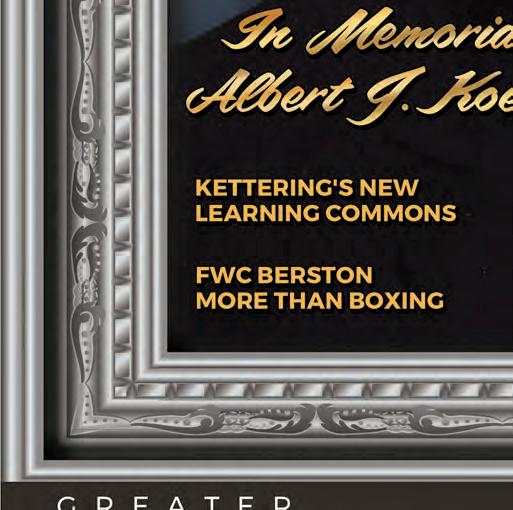

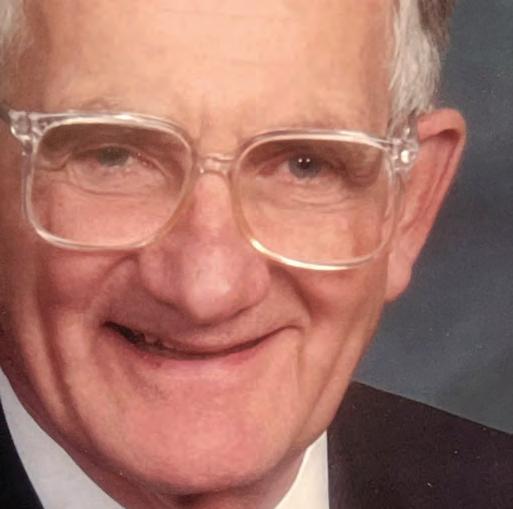


















New Independent Living Program helps Whaley youth transition out of foster care.
BY CHERYL DENNISON
Whaley Children’s Center in Flint has a new Independent Living program that will provide services for six young adults, ages 16-21. e multi-service approach addresses the physical, emotional and social needs of youth transitioning out of foster care and provides them with a safe place to call home while learning to be independent, according to Whaley President and CEO, Mindy Williams.
Called Journey Home, the residence is located in Downtown Flint just miles from the Children’s Center. “It’s hard to put into words how it felt to see the ÿ rst resident
walk through the door, but I can tell you there wasn’t a dry eye,” Williams shares. “ is has been a longtime dream to provide ongoing services to our kids as they leave the Center.”
As a provider of clinical and residential services, Whaley has seen the negative e“ ects of youth transitioning to adulthood without an adequate support system. “Many of our children stay in contact with us following transition into other programs or living on their own,” Williams adds, “and more often than not, we hear of the struggles and lack of ongoing support.” e outcomes for youth aging out of
foster care on their own are dismal, she states, and potential resulting di” culties include homelessness, unemployment, exploitation and dependence on various types of public assistance.
e new Independent Living Program (ILP) assists the young adults by providing programming support which includes clinical intervention, individual advocacy services, employment assistance, ÿ nancial planning, educational/ vocational planning, medical/dental assistance, mental health treatment, recreation and classes in life skills and mindfulness.
Community partners have teamed up with Whaley to create a network of strong, stable connections in the community that will help form lifelong relationships

necessary for them to succeed.
“Our team approach, including community partners, works to provide necessary support and services to improve safety, permanency and well-being.”
Peerless Mattress Co. generously donated mattresses to ensure each resident can rest comfortably.
GFL Environmental was so gracious to provide additional support for the new programming. “š ey are a great community partner and fully support the mission of Journey Home.”
Journey Home would not have been possible without a lot of hard work by the Center team, speciÿ cally, the previous Director of Program Development Casey Schlinker and current Director of Independent Living, Jen Koester. Williams reports. “š ey put in so much work to ensure this program would not only meet the needs of the struggling youth, but would

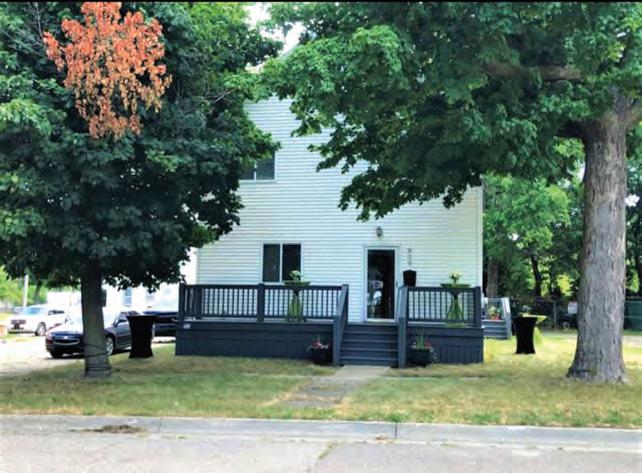
also set a new bar for standards we hope to see ripple throughout the State of Michigan.”
Whaley’s ILP will continue to expand. “š e State Farm Neighborhood Assist® Grant we won through a community voting platform provided us $25,000 to further support this program,” Williams happily shares. State Farm’s crowd-sourced philanthropic initiative empowers communities to identify issues in their neighborhoods. š e State Farm Review Committee selected the top 200 ÿ nalist recipients from 4,000 submissions.
“We fully intend to build upon these services over the next couple of years,” says Williams. A location for another home has already been secured and renovations are being planned. “I am so happy to have our Case Manager/ILP Coach
Missy Taylor on the team to assist with truly ensuring we are intentional with how this new home will be set up to most eŠ ectively meet the residents’ needs.”
Independent Living Programs were established to address academic and other skill development needs of youth aging out of foster care. Research suggests that gaining these skills is linked to improved educational, professional and ÿ nancial outcomes. š ese services compliment a youth’s own eŠ orts to achieve self-suŸ ciency and accomplish life goals. “Journey Home was a long, two-year emotional ride but we are ÿ nally here and ready to continue making a diŠ erence,” says Williams.


While the term “In Memoriam” always means a loss has occurred, I am so proud to have the opportunity to acknowledge a loss and honor a friend with this publication. On this month’s cover is community leader, Albert J. Koegel. We served together on the Flint Institute of Music Board of Trustees for many years, where I considered him a mentor. As a fellow businessman and “numbers guy” I enjoyed many conversations with him about business and ÿ nance. He lived a very long, productive and meaningful life, yet he is gone too soon. For more about Mr. Koegel, see p.6.
Flint’s rich history has been built on the contributions of so many people, businesses and institutions. Playing a huge role in our “College Town’’ is Kettering University, and their continued evolution is truly impressive. We got a tour of their innovative new Learning Commons – check it out starting on p.8.
Some people have contributed to our local history in more “down to earth” ways. Read about longtime businessperson (and fellow township supervisor) Tonya Ketzler, and the story of her family’s 170 year legacy as horticulturists (p.14).
Greater Flint is home to many businesses with long histories in Greater Flint including restaurants such as the “My Eats” subject, Brick Street of Grand Blanc. My family has enjoyed celebrating several signiÿ cant events there – Michael and Jackie Jablonski are always consummate hosts. Read more starting on p.22.
° e word “history” takes on special meaning when you talk about Berston Field House and F.W.C. Berston Boxing. OOn p.50, Mark Spezia writes about the “blue collar basement boxing gym” that keeps churning out champions.
Just for fun, we brought back our “Spectacular, Out of this World Pet Search” –we can all use a cuteness ÿ x these days, right? Our winner has a pretty great story – check it out starting on p.40. And for some Halloween fun, we have ghostly tales from around the state (if you’re into that kind of thing) starting on p.46. It’s deÿ nitely a transitional time of year; the outdoor event season wrapped up while the indoor season is just getting started. “Haps” coverage starts on p.66. So much more to come!
Wrapping up the content is our fall Wellness issue including the annual Wellness Award winners. Greater Flint is home to many top-notch health care providers –congratulations to all!
PUBLISHER & EDITOR IN CHIEF
MANAGING EDITOR
Sherron Barden
ASSISTANT EDITOR / WRITER
Peter Hinterman
STAFF WRITER
Cheryl Dennison
FREELANCE WRITER
Mark Spezia
CONTRIBUTING WRITERS
Erin Caudell
Dr. Christopher Douglas
Vera Hogan
Joel P. Lagore CFP, AIF
Alexandria Nolan
Leslie Toldo
Shannon White
GRAPHIC DESIGNER
Hailey Worrell
PHOTOGRAPHY
Katy Kildee
Jaden Maxlow
OPERATIONS
ACCOUNTING/CIRCULATION
Kim Davis
NEW BUSINESS DEVELOPMENT
Dan Garman
ACCOUNT EXECUTIVE
Terese Allen
° anks for reading, 5152 COMMERCE RD. FLINT, MI 48507 810.230.1783 ˛


PUBLISHER & EDITOR IN CHIEF VINCE@MYCITYMAG.COM


information and inquiries to: Editorial Department, My City Magazine, 5152 Commerce Rd., Flint, MI 48507, phone 810.230.1783. To authors, photographers, and people featured in this publication: All materials, articles, reports and photographs in this publication are the property of My City Magazine and cannot be used without written permission. ˜ e opinions and conclusions recited herein are those of the respective authors and not of My City Magazine. My City Magazine is not responsible for returning unsolicited manuscripts, photographs or other materials. Every e° ort will be made however, to return rejected manuscripts, etc., if they are accompanied by su˛ cient ÿ rst-class postage, but the publisher will not be responsible for any loss of such material. Copyright© 2022. All rights reserved. | Printed in U.S.A.




















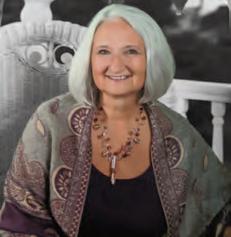


































8.14.26 - 8.24.22
Bornin Flint to German immigrants Anna and Albert, he attended St. Paul Lutheran School and high school at Culver Military Academy in Indiana. He returned to Flint to continue his education at Flint Junior College (Mott Community College), then explored the world serving for two years on a ship in the Merchant Marines, acting as its purser and pharmacist’s mate.
In 1950, Albert married his childhood neighbor Barbara (Gerholz). The couple’s early years were spent in Ann Arbor while he earned his MBA degree from the University of Michigan. Upon learning that his time in the Merchant Marines did not count toward his Selective Service requirement, he joined the U.S. Army and served in Korea as a first lieutenant during the Korean War. Following his Army service, Albert began working at Koegel Meats, a business started in Flint by his father
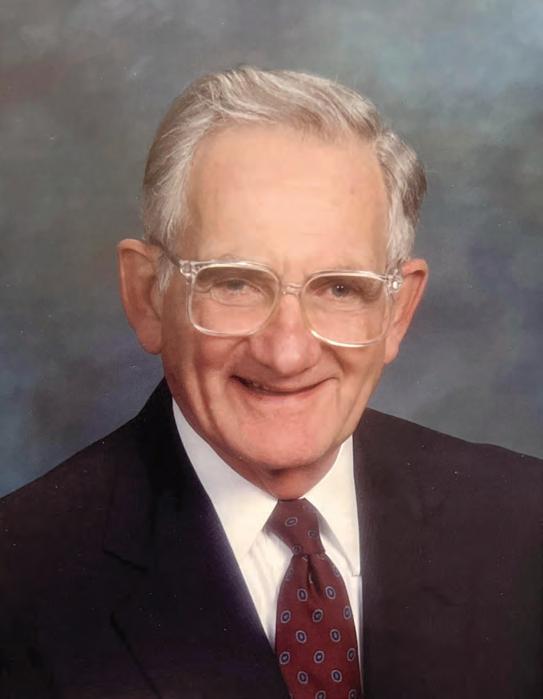
in 1916. In 1972, he built a new manufacturing plant next to Bishop Airport where he continued to work tirelessly for decades, even past his 90th birthday.
Always a lover of singing, he enthusiastically regaled friends, family and Koegel staff – much to their delight – with songs of every genre throughout his life. Devoutly faithful, Albert worshiped with song as a member of the choir at First Presbyterian Church of Flint for over 50 years.
Albert’s many civic involvements included serving as treasurer of the Flint Children’s Museum, the Flint Institute of Music, the Board of Trustees of Mott Community College, Flint Community Players and First Presbyterian Church of Flint. He was also a member of the Finance Committee for Mott Children’s Health Center, the Flint Rotary Club and the Genesee Regional Chamber of Commerce.
Apart from his professional life, Albert donated blood every eight weeks for many years, and was proud to have given a total of 198 pints. At age 81, he walked ten miles in The Crim. It was his dream to participate again at age 90, a goal he achieved in 2016 –singing all the while.
Last year, Albert and Barbara celebrated 71 years of marriage before she preceded him in death on September 1. They are survived by four children: Anne, Kathryn, Jane and John, and five grandchildren: Andrea Rocco; Katlyn, Chloe, Carson and Cameron Koegel. God, family, business, community, fun. Words, in that order, which Albert J. Koegel strove to live by. Prepared to sing for eternity in the Angel Choir, he passed away peacefully at home with family members present.












TWO YEARS IN THE MAKING, THE KETTERING LEARNING COMMONS IS UNIQUE IN HIGHER EDUCATION. IT FEATURES 105,000 SQ. FT. OF SPACE SOLELY FOR COLLABORATION OR GROUP LEARNING AND BOASTS NO CLASSROOMS OR OFFICES OF ANY KIND.
THE BUILDING WAS DESIGNED TO FOSTER AND EXHIBIT COOPERATIVE LEARNING. WALKING THROUGH IN ANY DIRECTION, A PERSON WILL CIRCLE PAST AND SEE STUDENTS WORKING IN ALL CORNERS AND D.SPACES.

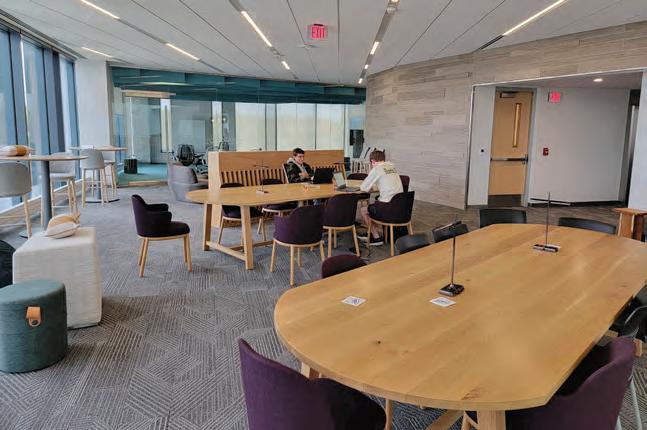


BY PETER HINTERMAN
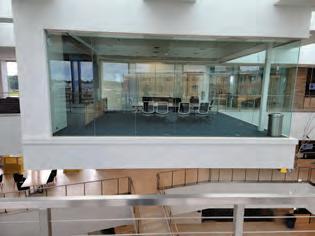

From its very beginning, Kettering University has been a unique institution. “We are different from most other universities,” says University President, Dr. Robert K. McMahan. “Since its founding, Kettering has treated real world practice as equal to classroom learning.” Kettering students spend just as much time at internships gaining hands-on experience as they do behind a desk. It is this style of learning, and the school’s unwavering support of it, that has helped gain Kettering its remarkable reputation across the nation as a trusted source of business and STEM professionals. Its unique style of education has also led to a surprising result. “Business in the real world works by collaboration,” explains McMahan. “What we noticed is that our students were bringing collaboration back from their own real-world experience. We had an idea and began to experiment with space to continue fostering the behavior. It was a hit.”
In 2016, Kettering began experimenting with a concept called a d.space. Started at Stanford University, a d.space is an area built entirely for students to meet, collaborate and work together to solve complex problems or complete projects. A standard d.space comes equipped with nearly everything needed for success including whiteboards, seating, electronic connectivity and WiFi, monitors and other tools. Each space can be set up EVERY COMMUNITY SPACE AND MEETING ROOM HOLDS THE TOOLS FOR STUDENTS TO WORK ON THEIR PROJECTS SINGLY OR IN A GROUP FORMAT. THE FLOATING OWENS CONFERENCE ROOM AND TOMUSKO REFLECTION STUDIO STAND OUT.
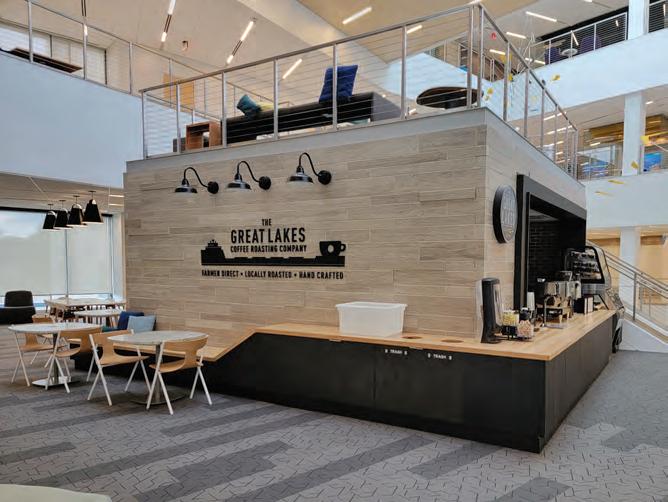
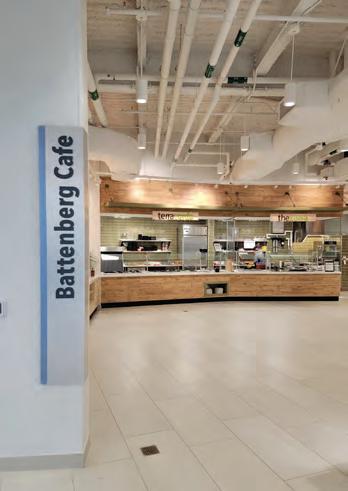
IN THE CENTER OF THE BUILDING, THE GREAT LAKES COFFEE COMPANY MEETS THE STUDENTS’ REFRESHMENT AND ENERGY NEEDS.
THE BATTENBERG CAFE SITS READY AT THE GROUND FLOOR TO PROVIDE FOOD AND BEVERAGE FOR A HUNGRY STUDENT ON THE GO. STUDENTS CAN EAT ANYWHERE IN THE BUILDING.
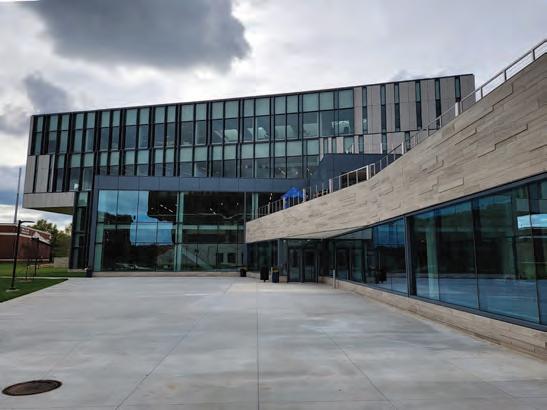











di˜ erently, with the common feature being one transparent wall that allows others in the building to see collaboration taking place. “We began to set up d.spaces in our other buildings to see how students responded,” says McMahan. “° ey were extremely popular and that got us thinking about how to expand on the concept.” ° e idea for the new Kettering Learning Commons was born.







“We went into the design of the building di˜ erently,” McMahan explains. “Instead of asking what the building needs to provide for students, we asked what behaviors we want the design to foster.” ° e answer was a facility that is unheard of throughout academia – a great leap forward in education. “° e Learning Commons is unique in higher education. ° ere is nothing like it,” adds McMahan. “° e building is 105,000 square feet and contains no o˛ ces or classrooms of any kind.” Already, the building is making a splash across the nation. Kettering recently welcomed a representative from Tulane University in Louisiana to tour the building and is setting up dates for many others.
Instead of housing classrooms, the Learning Commons is based upon the idea of the d.space and provides 12 collaboration rooms in addition to other community areas. No two d.spaces are alike, so students can choose the one they feel most comfortable with as long as they follow the four rules of the Learning Commons:
1. No space is owned by any department, class, or group.
2. No group has priority over any other for a space.
3. There are no reservations. The rooms are first come, first served.
4. Once a space is occupied, the occupants can choose whether to share a space or not.


IN HONOR OF THE KOEGEL FAMILY’S DEDICATION TO FLINT, KETTERING HAS DESIGNATED THE KOEGEL PLAZA FOR STUDENT COOKOUTS AND OUTDOOR CELEBRATIONS.









“A space can be populated by a single student or a class full – it’s up to them,” says McMahan. As a sneaky little design feature, the building in nearly its entirety acts as a d.space. It was designed to provide sight lines to nearly every corner and paths were built to encourage collaboration. As a person walks throughout the building in any direction, they will circle past and see students working.














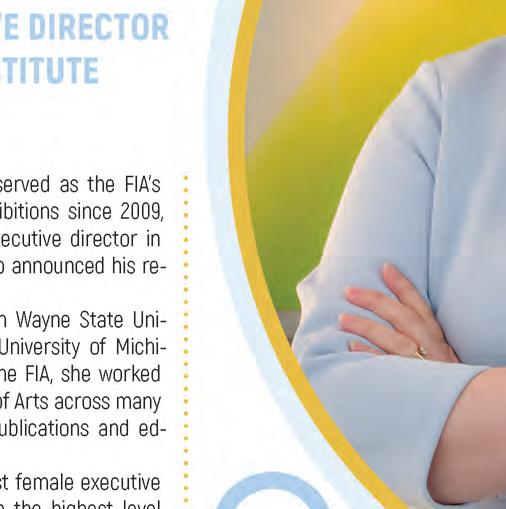


















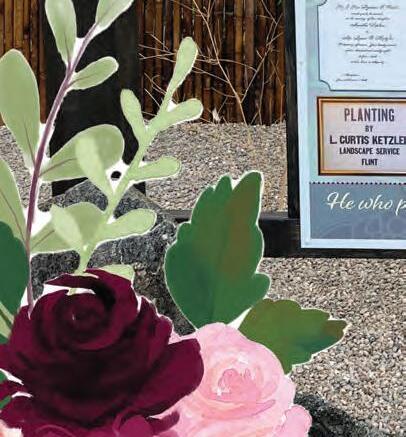






THE KETZLER FAMILY WAS ORIGINALLY IN THE DAIRY BUSINESS (TOP). TONYA’S GRANDPARENTS LYMON AND DOROTHY KETZLER (ABOVE) OPENED KETZLER GARDEN CENTER ON MILLER RD. AT BALLENGER HWY. IN 1956.







BY CHERYL DENNISON








˜ e Curtis/Ketzler family has a 170-year history of horticulture in Genesee County. Tonya Ketzler, Mundy Township Supervisor and former owner of Ketzler Flowers, is proud of her family’s heritage and works hard to preserve it.



“˜ e Curtis family was in the landscaping business (Mundy Township) and the Ketzler family was in the dairy business (Flint Township),” she explains. ˜ eir 170 years of horticulture in this area began in the 1800s. In 1879, the Ketzler family had acquired 170 acres of tillable farm land in Flint Township. L.T. Curtis and ÿ rst wife Florence Bigelow had four children, including Martha Curtis. “Louis Ketzler was born in 1869 on the family farm on Miller Road,” Tonya continues. “On June 22, 1898, Martha Curtis married Louis Ketzler (my great grandparents) in Mundy Township, combining the Curtis and Ketzler family names.”
Lymon Curtis Ketzler was born in 1903. He met Dorothy Smith when Dorothy was working at Curtis Flowers. ˜ ey later married and together, they (Tonya’s grandparents) opened Ketzler Garden Center in 1956 at the corner of Miller Road and Ballenger Highway. “It was quite the place!” Tonya exclaims. ˜ e garden center moved to Hill Road in 1963, and became Ketzler Florist in 1967.
In 1968, David and Peggy Ketzler (Tonya’s parents) took over operation of the ˛ ower shop. After WWII,


“I grew up in the horticultural business. It’s in my blood – I didn’t have a choice!”
Tonya Ketzler




David, following in his father’s footsteps, got his landscaping degree from Michigan State University and joined his Uncle George at Genesee Nursery. Both Curtis and David Ketzler did a lot of the landscaping for estates o˜ Miller Road in Flint. “In 1968, my dad decided he was too old to dig holes anymore,” Tonya remembers.
Tonya was born in 1951. In 1983, she opened a successful business, Ketzler Florist Too, in Swartz Creek. She took over the Hill Road shop in 1994 and became the third generation to own Ketzler Florist.
In 1995, Tonya moved into her grandparents’ home – a white farmhouse that sits next to Ketzler Florist on Hill Road. Built in 1930, the house contains many photos and family memorabilia. “My job is to keep up the history that was passed to me by my ancestors,” she says. “I grew up in the horticultural business. It’s in my blood – I didn’t have a choice!”










Initially, Tonya had no interest in the family business, as she was allergic to ° owers! She studied to become a museum curator but returned home to help her family operate the ° ower shop. She remembers a day when she was helping a man pick out funeral ° owers to place on his wife’s casket. “˛ ese were the last ° owers he was going to give her,” she recalls. “I wanted to make sure they were perfect for him. I didn’t go back to school. I had realized that in this business, I could make a person’s saddest and happiest life moments better.”
















BY PETER HINTERMAN PHOTOS PROVIDED BY CLIO CENTER FOR THE ARTS
If you have a budding interest in anything artistic, Great-
er Flint holds a few places of opportunity. One often overlooked school, sitting o˜ of Vienna Rd. just west of Downtown Clio, may be just what you are looking for.
Clio Center for the Arts (CCA) was founded in 1989 with the mission “to enrich the community by building partnerships to provide a variety of artistic experiences for personal growth” and for the last 33 years has stayed true to that mission by o˜ ering a smorgasbord of art experiences for students of nearly all ages, ability and interests.
“Local artists founded the Clio Area Arts Society in 1989 to expand the arts in the area,” explains CCA President Jan Warner. “In 2014, we moved to our current location and changed the name to Clio Center for the Arts.”
Today, CCA boasts three classrooms, a gallery and a kiln room. “° e kiln room is open for public use for anyone, member or nonmember,” Warner explains. Classes at CCA include pottery, stained glass, weaving, painting
(watercolor, oil and acrylic), mixed media, resin, drawing and more. “° ere is really something for everyone here,” adds Warner, “and if you are interested in learning a skill that is not currently o˜ ered, ask us – we will do our best to ÿ nd an instructor if there is demand.” Classes are o˜ ered during daytime and evening hours for adults and kids aged six and older.




° e CCA also o˜ ers homeschool-compatible art classes, general arts & crafts time for kids, and sessions for seniors or disabled residents from assisted living facilities. “We bring them in twice a month to express themselves through art and learn new skills,” adds Warner. ° e general children’s class o˜ ers seasonal projects, pottery, painting, holiday projects or anything else the kids are interested in that is age appropriate.
For those who can’t wait to unveil their artsy creations, the CCA houses the Margaret Runyan Gallery & Art Boutique. ° e gallery is used to showcase the artists

















at CCA, as well as the works of professional artists from around the city and state. “For newer artists, we advertise and hold a reception for them,” Warner states. “We designate a small section for our artists to showcase and sell their works.”
Since the pandemic, CCA has found itself in high demand with classes ÿ lling up quickly. “° e two most popular right now are pottery and stained glass,” adds Warner. ° e majority of classes run as two-week sessions and the CCA asks that each potential student pre-register and joining a class once it has begun often comes with an additional fee. It’s best to check the website periodically, as not all classes begin or end at the same time.

° e quality of the instruction and a˛ ordability have made the CCA a destination for many in and around the area. “We have had students from Midland, Caro, Vassar, Flushing, Swartz Creek, Grand Blanc – from all over,” boasts Warner. “We are one of the few art schools with a building with classrooms and we do our best to keep classes a˛ ordable for everyone. Come in and check us out!”


For a list of available classes and upcoming exhibitions, visit cliocenterforthearts.org. Class registration is available online or by calling 810.547.7087.
Clio Center for the Arts is always looking for the best way to bring art education to the Greater Flint community and that includes quality instructors. Currently, they are in need of knitting and crocheting instructors to ÿ ll a request from potential students. Interested instructors should call CCA – the process includes completing an application and interview.


“THERE IS REALLY SOMETHING FOR EVERYONE HERE.”
Jan Warner , CCA President




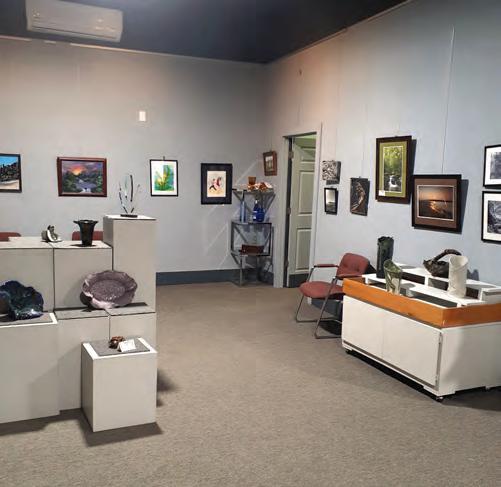


























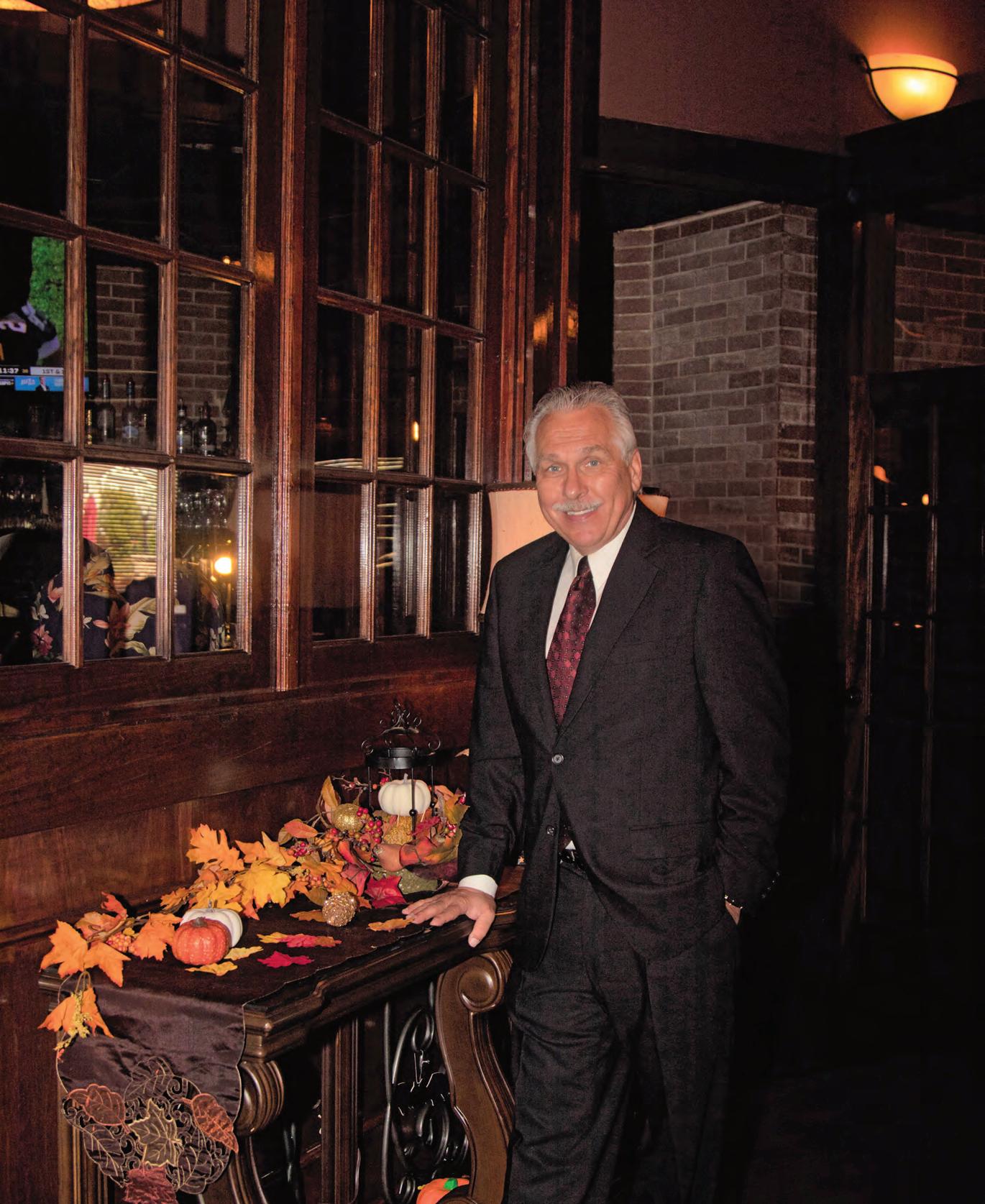
BY CHERYL DENNISON
Brick Street of Grand Blanc is not just a restaurant – it’s an experience! The pub, patio and variety of dining spaces and banquet rooms offer the ideal place to enjoy a casual meal or fine dining experience, enjoy entertainment or hold your special event. The popular restaurant, which is centrally located, opened in 2001 and is owned by Michael and Jackie Jablonski who have been in the food and entertainment business for many years.
Whatis Brick Street? “We have several identities,” Jablonski shares. “We are an old-school style of restaurant, which is something I want to maintain, and we are one of just a few places that provides full service for events.” He also noted that the experience is different for everyone. Many people love the Brick Street Pub, with seating for 130 people, and there are many charming indoor areas to choose from for a special dining experience, including four dining rooms and private dining rooms. From May to September, the spacious outdoor patio is typically packed with diners enjoying live entertainment.
Like many other area eateries, Brick Street endured some dark times over the past couple of years and was closed during the pandemic shutdown; but Jablonski remained positive. “Due to supply and staffing issues, things
WE ARE CONSTANTLY MAKING NEW MEMORIES FOR OUR GUESTS AT BRICK STREET. IT’S GOT A NEW LIFE EVERY DAY.”
Michael Jablonski

had to change,” he states. One thing that changed is the hours of operation – the restaurant is currently open from 3-10pm on Tuesday-Friday and noon-10pm on Saturday and Sunday (closed on Monday). “We had to adapt and plan for the future,” he explains. However, they plan to expand business
hours by re-opening for lunch in the near future.
A staff of 42 employees have helped Brick Street of Grand Blanc remain a popular dining destination and continue to grow. “I’m fortunate,” says the owner. “I have key people who have been with me a long time.

OWNER MICHAEL JABLONSKI IS PROUD TO HAVE MANY LONGTIME KEY STAFF MEMBERS, INCLUDING CHEF JAMES TYLER. ▶
I have some great employees.” One of those employees is Banquet Manager, Judith Bertram. “I can’t say enough about her,” says Jablonski. Also on staff for over ten years is 26-year-old General Manager Alan Mulholland, who started as a busboy and worked his way up. “He’s done every job here!”
Jablonski exclaims. Other key employees include Assistant Manager Tracie Richardson; Kalen McIntosh, who is in charge of the pantry; and bartenders Joe Nagy and Scott Smith. “I believe I have two of the best bartenders in town,” Jablonski adds.
Preparing the delicious variety of dishes are Chefs James Tyler and Peter Woodman, with assistance from Sous Chef Eric Pickens, Jr. “They have all been with me a long time and are fabulous people.” Although Jablonski says he has no intention of getting out of the restaurant business any time soon, he is working with his valued staff to pass the torch when he does. “My legacy is going to be my staff. I want them to be prepared for life and for business.”
The food is one driving factor of Brick Street’s success. The menu changes almost every week and is much smaller now. One of the most popular entrees is the glazed mango salmon, brushed with mango BBQ sauce and baked, then topped with citrus relish, served with mashed sweet potato and vegetable du jour. Another favorite is Bangkok chicken (below) – a stir-fry with oriental vegetables, bell peppers, red onion, bamboo shoots, water chestnuts, fried rice and
chili glaze. “And our BBQ baby back ribs are fabulous,” the owner exclaims. “We smoke them outside on the premises.”
A new menu addition has personal meaning to Jablonski, as it was created in honor of his father, Raymond Jablonski.
The dish, Raymond’s Polish Dinner, was one of his dad’s favorite meals: grilled Polish sausage, sauerkraut and stuffed cabbage rolls served with potatoes.
“Raymond was a wonderful person,” says Jablonski. “He taught me a lot. I want to remember my father and publicly keep his memory alive.”




Also very popular are the Thai Lettuce Wraps on the appetizer menu. The “build your own” plate (below) includes char-grilled Teriyaki chicken, carrots, julienne peppers, crispy wontons, sesame-pickled cucumbers and leaf lettuce leaves – served with three flavorful sauces: red chili, orange ginger and jalapeno.

Brick Street is well known as the place to go for your special event –wedding receptions, showers, business dinners, graduation parties, funeral dinners and more. Jablonski remembers one day when there was an event going on in every banquet room. “A baby shower, wedding reception and funeral dinner were all held at the same time,” he remembers. “We experience the circle of life here.”
On the second Thursday of each month, Brick Street has a wine gathering and the multi-talented Jablonski himself provides the entertainment –playing the piano and singing. “A lot of people come to this!” he exclaims with a smile.
The customers are what make the care and attention to details that Jablonski is known for all worthwhile. “I have to give a shout out to my wife, Jackie,” he says, adding they have been married for 40 years. “She is the love of my life and has been with me every step of the way.”
Jablonksi’s vision for Brick Street of Grand Blanc has always been to provide a great experience and a place where people make memories. “I love our customer base,” he says. “There are a lot of regulars and many people have known us for many years. Their support is unbelievable.” And, the key to the restaurant’s continued success is providing great service, which Jablonski says they will continue elevating to the next level. “We are constantly making new memories for our guests at Brick Street. It’s got a new life every day.”















As we grow older, it becomes important to dedicate our energy to taking good care of ourselves, our bodies and our security. By taking the initial steps to prepare for our later years while we are still full of health and vigor, we can ensure a longer and happier life.
Two of the biggest in˜ uences on the quality of an older person’s life are serious illness and a sudden fall. Falls are the leading cause of both fatal and non-fatal injuries for seniors with over one-fourth taking a signiÿ cant tumble each year. And, in today’s climate of COVID and ˜ u, respiratory illnesses like pneumonia are far more common. Read ahead for tips to avoid both potential hazards and start to make the changes you need NOW for your future and that of your loved ones.












The leaves are falling, but your proactive health measures don’t have to –
AGAINST PNEUMOCOCCAL PNEUMONIA.
Pneumococcal pneumonia is a potentially serious bacterial lung disease that can disrupt your life for weeks. In severe cases, it can put you in the hospital and even be life-threatening.

all the fun activities that come with the changing of the season, it is the perfect time to enjoy the outdoors with friends and family. But along with the changing seasons and a slight chill in the air, come the looming days ahead of increased respiratory infections. This fall, don’t let pneumococcal pneumonia get in the way of taking in all the things this season has to offer.
Here are some fun, health-oriented activities to try this fall:
▸ Take long walks outside: One of the best ways to stay active as the weather changes is taking a long walk to enjoy the fresh, crisp air.
▸ Pick your own apples: Enjoy a healthy snack full of fiber and antioxidants
advantage of fresh, organic fruits and veggies at your local farmer’s market, while supporting local businesses and farms.
▸ F ind out if you’re at risk for pneumococcal pneumonia and learn about vaccination to help prevent it.
Pneumococcal pneumonia can strike any time of year, and pneumococcal vaccination is available year-round. While you’re getting vaccinated against flu this season, don’t forget to ask your doctor or pharmacist about pneumococcal pneumonia vaccination. Even if you’ve already had a previous pneumonia vaccine, your healthcare provider may recommend it for additional protection.
The risk for pneumococcal pneumonia increases for adults 19 or older with certain chronic health conditions, including asthma, diabetes, COPD, and chronic heart disease, among others. People aged 65 or older are also at increased risk for pneumococcal pneumonia, even if they’re generally healthy, because the immune system weakens with age.
No matter the season, it’s important to think about what you can do to help protect your health. Don’t wait – talk to a doctor or pharmacist about pneumococcal vaccination. To learn more about the disease, risks, symptoms and more, visit KnowPneumonia.com.


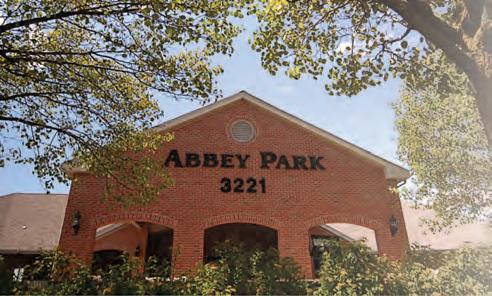

BY KATHLEEN FELIX, ADMINISTRATOR ABBEY PARK INDEPENDENT SENIOR LIVING
Community: it is the ÿ rst word that comes to mind when describing Abbey Park Independent Senior Living.
Webster deÿ nes the word community as “a shared ownership or participation.” At Abbey Park, a strong sense of community permeates the 175,000 square feet of space and shows in every one of the smiling faces of our residents and sta° alike. ˛ is sentiment is fostered by the fact that Abbey Park is owned by local partners who believe strongly in the power of fellowship, security, kindness, polite manners, humor, humility and a good, old-fashioned philosophy known as “˛ e Golden Rule.”
As Abbey Park administrator, I count my blessings daily that I have been able to serve at the helm of such an amazing and beautiful place for 14 years. From the beginning, it was evident to me that the partners whom I call my bosses – the owners of Abbey Park – realize that o° ering a great quality product for a reasonable price translates into good business. ˛ eir mission statement re˝ ects this sentiment, as they state their commitment to o° ering a° ordable housing and services of the highest quality, delivered with warmth and caring. ˛ eir goal is to foster the physical, mental and emotional stability of all residents. Companionship between residents and sta° is encouraged. In fact, Abbey Park’s mission statement reads, “… all residents are treated just as we ourselves would like to be treated.”
Abbey Park is absolutely a community and we work together to create a wonderful home and place of employment for all. We know every one of our residents’ names and treat them as family. Of course, we could not run this business without our hardworking and friendly sta° . Housekeeping and maintenance crews are both top notch. ˛ ey take pride in maintaining an environment that is kept spotlessly clean, and repairs are completed as quickly and e˙ ciently as possible. Our cooks and dining room teams work tirelessly to prepare and serve hot, nutritious, healthy meals, while always wearing a smile. Onsite medical team supervisor, nurse and caregivers are among the best in town. Life enrichment services, activities and trips engage even the less active senior residents.
One thing I love to say is that “they thought of everything” when the partners created Abbey Park. Promoting the independent senior lifestyle while allowing for the “as needed” personal care assistance is genius. None of us is getting any younger, and sooner or later most will need some sort of help, be it with taking medications, with showering and grooming or getting in and out of bed. Nearly everything o° ered in an assisted living facility is available here, right in the comfort of one’s own apartment. ˛ e cost for enhanced independent living is reasonable, much less than one ÿ nds in a comparable assisted living facility.
Visitors seeing our place for the ÿ rst time are amazed that the apartments are so spacious and well laid out with complete kitchens and ample closet space. ˛ ey love the common areas such as our lobby, library, country store, hair salon, activities room, co° ee shop, dining room, exercise room and movie theater. ˛ e reasonable monthly rent includes most utilities, beds are made and trash removed daily, apartments are cleaned each week with linen service and a freshly made bed.
Come and see us at Abbey Park and you will see for yourself how to “Live here … for the best of your life!”
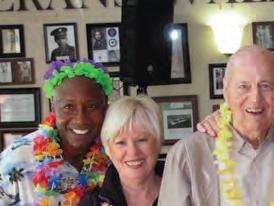
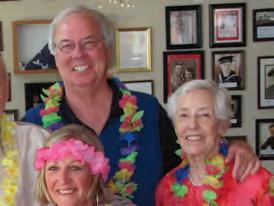



















When you’re active and young at heart, it’s easy to forget that you may be losing some strength, flexibility and balance as you age.
Becausethese changes happen gradually, you may be unaware of the added risks of falling. That risk can sneak up on you as you’re busy enjoying life.
But the facts don’t lie: Falls are the leading cause of both fatal and non-fatal injuries for older Americans, and over one-fourth of older adults falls each year.
Fall injuries can include hip fractures, broken bones and head injuries. Every year, medical costs spent on fall injuries are about $50 billion, according to the Centers for Disease Control and Prevention (CDC).
But falling is not an inevitable part of aging. Many falls can be prevented by taking simple, proven steps. Here are five ways you can reduce your risk.
▸ Start with a checkup. The first step is to understand your risk for falling. The National Council on Aging offers the Falls Free CheckUp, a simple online questionnaire that is based on
research and guidance from the CDC.
In a few short minutes, you can answer 13 yes or no questions, receive your falls risk score, and get easy steps you can take today to reduce your risk. You can even download your results to discuss with your doctor and sign up for a reminder to retake the Falls Free CheckUp six months later to see if your risk level has changed.
▸ Remove hazards. A whopping 60% of all falls happen at home. That’s why it’s a good idea to walk through your home with a fresh, critical eye to determine whether any areas should be addressed. Floors should be clutter-free, with throw rugs either removed or held down with double-sided tape. All stairs should be well-lit and equipped with strong rails. In bathrooms, tubs, showers and toilets should be equipped with grab bars. Another great option is an in-shower chair used in combination with a hand-held shower head.
▸ Keep on top of your health. Having regular checkups with your doctor will keep you aware of any changes that may have occurred, such as muscle weakness or issues with your vision, balance or gait. People with mild hearing loss are nearly three times as likely to fall as others. The symptoms of chronic conditions such as diabetes, heart disease and arthritis can also increase your risk of falling.
▸ Stay active. Ask your doctor which kinds of exercises may help you reduce the risk of falling. Senior centers, YMCAs, Area Agencies on Aging and gyms often offer classes geared toward falls prevention, with many focusing on mobility, balance, strength, flexibility and/or behavioral changes that may help you.
▸ Monitor your medications. Certain prescription and over-the-counter medications can cause dizziness, sleepiness or dehydration. Interactions with other medicines can also increase your risk of falling.
Learn more about how to stay independent and injury-free at NCOA.org.











For many people, the process of cremating a loved one is a mystery. At Swartz Funeral Home, our ten-step process guarantees that your loved one is well cared for at all times.
1.Code of Ethics
We adhere to a strict code of ethics and procedures while your loved one is in our care. We only use Country Roads Crematory, a member of the Cremation Association of North America, who we know and trust to uphold these ethical standards.
2.Safeguarding Personal Identity
A personal I.D. tag is placed on your loved one the moment they are transferred into our care.
3.Unique Tracking System
Upon arrival at the crematory, your loved one is logged into a tracking system and assigned an I.D. number, which is stamped into a stainless steel tag to track every phase of the cremation process.
4.Family Identifi cation
Our sta˜ properly encases your loved one in the cremation container selected; then, we verify
identity by comparing I.D. bands from the hospital or nursing home. In the case of a death at the family home, positive I.D. occurs when we arrive at the residence.
5.Checks & Balances
A crematory technician and licensed funeral director reviews all cremation paperwork and permits. Once all documentation is veriÿ ed, the technician starts the cremation process.
6.Cremation Log Book
Immediately prior to the cremation process, your loved one is taken to the crematory and their personal I.D. is logged containing the name, date, I.D. number and crematory operator’s name. It is dated and initialed by a cremation technician before and after the cremation.
7.During the Cremation
˛ e crematory checklist and I.D. card are placed on the outside of the cremation chamber during the cremation process. ˛ e metal I.D. tag is present in the cremation chamber during the process.
8.Post-cremation Details
After cremation is complete, the remains are placed with the stainless steel I.D. tag into an urn. ˛ e I.D. card and cremation certiÿ cate are placed into our permanent ÿ les.
9.Return of Remains
Our sta˜ will notify you to schedule a time for picking up the cremated remains.
10.Celebration of Life
To appropriately celebrate the life of your loved one, we assist you in planning a funeral or memorial service either before or after the cremation.
We are happy to answer any other questions you may have about our cremation process, and the commitment we have to every family we serve.

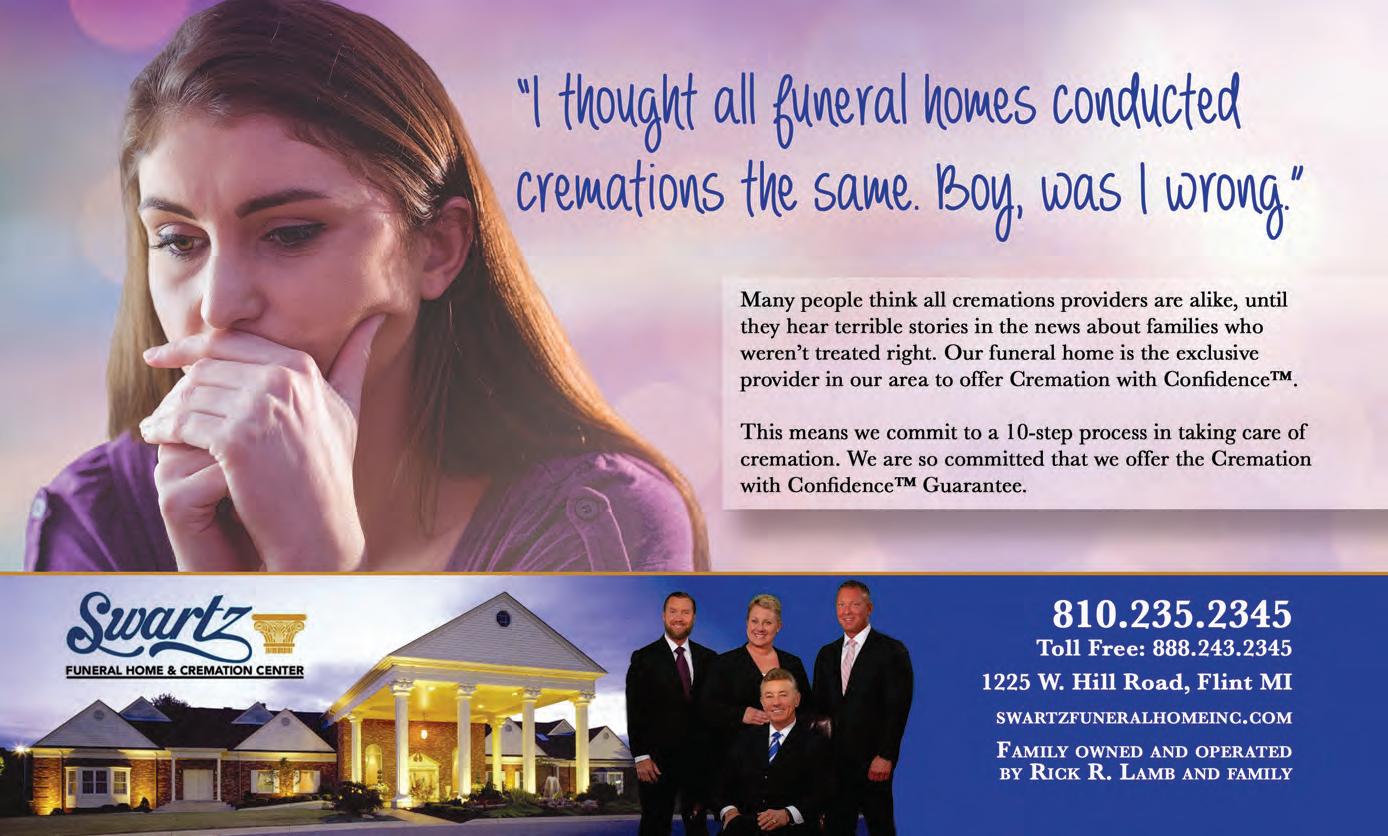
















NEW FOR 2022: FUNDS RAISED FROM PINK NIGHT
PALOOZA CAN BENEFIT LOCAL PATIENTS FIGHTING ALL TYPES OF CANCER!
For the past 14 years, Hurley Medical Center and Financial Plus Credit Union have raised money to help breast cancer patients pay bills, keep food on the table and so much more. Starting this year, Pink Night Palooza is sharing the love with local patients battling ALL TYPES OF CANCER.












Hurley’s cancer program has received continuous approval from the Commission on Cancer of the American College of Surgeons (ACoS) since 1956 and meets the qualiÿ cations for a Community Hospital Comprehensive Cancer Program.
Our dedicated team of trained oncology specialists are involved in every aspect of screening, diagnosis, treatment, recovery and rehabilitation of our patients. Our board-certiÿ ed physicians and nurses (certiÿ ed by the Oncology Nursing Society) develop individual, comprehensive patient and family-centered treatment plans for each patient.
Hurley Medical Center’s highly skilled oncologists and staff treat all types of cancer, including:
• Breast Cancer
• Cervical Cancer
• Colorectal Cancer
• Bladder Cancer
• Kidney Cancer
• Lung Cancer
• Prostate Cancer


• Soft-Tissue Tumors
• Spine Cancer
• Testicular Cancer
• Upper Gastrointestinal
• Leukemia
• Lymphoma



Sponsors and attendees alike will be able to choose where their donations go – Hurley’s Breast Cancer Navigation Fund or General Cancer Services Fund. Now more than ever, your donations and sponsorships will enable Hurley to help more cancer patients in our community.
So join us ° ursday, October 20 for the LIVE in-person and on-air event ÿ lled with peace, love and PALOOZA – all the best parts of a community that bands together!
PROCEEDS FROM THE EVENT SUPPORT
BREAST CANCER NAVIGATION FUND CANCER SERVICES FUND
With services extended to our patients treated through Genesys Hurley Cancer Institute.
FOR QUESTIONS, PLEASE CONTACT Patricia Creighton at 810.262.9669 or pcreigh1@hurleymc.com.
GET TICKETS @ PINKNIGHTPALOOZA.COM













BY SHANNON WHITE
Changing leaves, cool days, football games, trips to the cider mill … fall is here! Something else about fall that makes us happy – besides the cider mill donuts – is the fashion. It’s time to get cozy and embrace the fall trends and must-haves!
During the fall months, layering is key to fashion success. This year, there are two great pieces to successful layering: having something smart and versatile for work and a cozy layer for the rest of the time! The “smart” layer for this season is the tailored blazer – double breasted, without buttons – it doesn’t matter, but having one is key.
It can easily dress up an outfit, become your outermost layer over a cute top, a tank, a bodysuit and jeans, or even over a sweater. The next fall necessity is the cozy wrap. It’s so versatile! Throw it over your favorite button-down with jeans, your t-shirt and leggings, or even a sweater on really chilly days. It’s great for sitting around a bonfire or snuggling on the couch, catching up on Netflix. SHIFT has multiple colors, so you’re sure to find one you like.





Long-sleeve dresses are another fall wardrobe staple and this summer’s ruffles or puffed sleeves are still trending. If a fall wedding is on your social calendar, a great dress – maxi or mini – is a classic choice. The long sleeves with fun cutouts and the swishy skirt of The Clothing Company’s Sand Dollar Dress are perfect for that fall wedding. For something more casual, look at the Anna Kaci Tiered Black Dress and pair it with sneakers for running errands or grabbing lunch with friends on a sunny, fall day or great boots for a fall harvest meal in the evening.

Evergreens are timeless and hold their color all year long. It’s no secret, nature always inspires, and green is a hot color this fall. Pair a top like the Sugarlips Karly Lace Princess Top with jeans for a casual night out or dress it up with black pants and heels. Or add green accents to your look with a new bag! The Haute Shore Greyson Neoprene Tote will give your outfit a pop of green that will brighten up a dreary, Michigan fall day.
Tired of the ruffles? Try fringe, instead! The Cezele Faux Suede Jacket is perfect for a cool fall day! Keep it casual with denim or wear it over a dress or with a skirt. The neutral caramel color will go with just about anything in your wardrobe. Or, check out the Suede Sleeveless Top by TCE for a cool look on a warmer day and the adorable, smaller purses from SHIFT fave, Ahdorned, have a fringed outer seam that makes them the perfect wardrobe accent piece!
Whether you embrace the cooler weather or mourn summer’s end, a wardrobe refresh is fun for everyone! SHIFT in Downtown Flint can provide you with the cozy pieces you need and the fun, trendy items to keep your look current – and warm!

Shannon White is an architect, designer and fashionista – a small but mighty cheerleader of all things Flint! Holding both Bachelor of Science and Master of Architecture degrees from the University of Michigan, she is the founder of the FUNchitecture design firm and co-founder of she-powered Downtown Flint retail business, SHIFT.


















All of the Pet Search Nominees are stellar in their own right, but we chose to share the story of Bubbles and his special mission. Congratulations, Bubbles!
Bubbles “˜ e Blind Beagle” Dinsmoore of Otisville was born with genetic defects which caused him to lose his eyes this summer … but he hasn’t let it slow him down! He recovered and has adapted to his disability with the help of his parents Stacie and Brent, and Nugget – his fur sibling and
seeing-eye Beagle. He now travels around the state with his Jeep, using his huge personality and charm to advocate for those facing physical challenges.
“He may not see the world, but the world sees him shine wherever he goes!” says his mom, Stacie.
˜ roughout October – National Bullying Prevention Month – Stacie and Bubbles will load up his Jeep and roll up to many area elementary schools to visit with students. “We hope to visit a school every day in October to advocate









for those with disabilities and teach children to have empathy and compassion for those who are unlike them.”
Bubbles always has a big smile as he rides in his remote-control Jeep visiting the classrooms. “He is a perfect example for kids to learn that even if you have a disability, you can live a happy, normal life,” Stacie says. “Bubbles’ lesson for them is that if you can have compassion for other people, the world will be a much better place.”












If you’d like to invite Bubbles for a school visit during National Bullying Prevention Month, visit his Facebook page: facebook.com/bubsandnugs/
One thing is for sure, their owners think these superstars are the best pups on the planet!
















Owner: Jessica Revoldt
Nona is a red-nose princess who sleeps under a 25lb weighted blanket. She loves people and gets a massive case of wigglebutt for visitors. She loves food, digging ankle-twisting holes in the yard and napping. Dislikes include groundhogs in her yard, ear ointment and nail trims.
Registered Name: Jacknic’s Matty on Cloud Nine
Owner: Cheryl Ashford
Our Standard Poodle Matty is a farm dog, Dog Scout and American Kennel Club S.T.A.R. Puppy program graduate: this stands for Socialization, Training, Activity, and a Responsible owner – the pillars of good puppy ownership. He is a very happy boy!
Owner: Sheri Cormier
We purchased Annie from a breeder who advertised the puppies as YorkiePoos, only to ÿ nd out later she is more Chihuahua than anything else (Chi-York-Poo). Haha!
But we sure do love her, just the same.
Owner: Megan Kennedy







We adopted Fynn ÿ ve years ago from Humane Society of Genesee County and our family has been complete ever since. It was love at ÿ rst sight! We knew Fynn was “the one” when we ÿ rst met her, because she crawled into my lap and rested her face on my shoulder. She has legs that aren’t fully developed; our vet believes that she was just born that way. During her ÿ rst year with us, she received training and therapy to strengthen her back legs. Today, she’s better than ever! Most people wouldn’t even know that she has a disability. She loves to run in the backyard and sun herself on the patio. Her “bad legs” don’t stop her from living her best life. We adore Fynn and are so thankful that we had the opportunity to adopt this very special girl.

Owner: Keri Kostich





Our 2 ½-year-old Newfoundland LOVES boat rides and swimming! And of course, he looks super-handsome in any costume!




Owner: Mindy Smith





My name is Ser Radar Sirius Cornell Smith-Lynch. I am a ÿ ve-year-old goodest boy. Me and my sister are always trying to do “tough wolf stu° ” but my mama likes to dress us up. When I see the costume bag, I usually run for the hills! But this time, she caught me. I do feel kind of cool in my vest ... but don’t tell her I told you that.

Owner: Jashell Mitchell
˜ is beautiful, 7-month-old Maltipoo loves to play with her stu° ed animal and chew toys. She is very smart, attentive and active. She loves her family very much and likes to take trips in the car and ride “shotgun” in our laps.









At these local businesSes, furRy friends make the workday much more fun!


Our 12-year-old liver Dalmatian (brown spots instead of black) spends her days welcoming our customers with a smile and a wagging tail. People often come to the store just to say “hi” to Stormy. While she might not be the best at ÿ nding someone a book, she is a very valuable member of our sta° .





On the day after Labor Day, this kitten was discovered curled up in a car’s engine compartment! We heard him crying and attempted to ÿ nd him – he thought he was being chased and ran to hide in the woods. It took us all day, but with the help of some friends from our local rescue community he was ÿ nally trapped that evening. At ÿ rst, we thought he might have been feral; but the next morning he was allowing us to pet him, even if he was still a bit skittish. Now, he loves people! He is also nicknamed “Detroit Motor Kitty” because of how we found him.
SubmitTed by SherRon Barden, Editor
Our beloved O˛ ce Pup of 16 years, Oscar, went to Doggie Heaven two years ago. When Stu the Maltipoo came into our lives last year, he was instantly promoted to the position! While he’s still working on his visitor-greeting skills and using his “indoor voice,” his cuteness makes up for it. When he’s not power-napping in my o˛ ce or attending meetings, he likes to play with his coworkers and check his emails.















BY PETER HINTERMAN

It was dusk. A misty chill hung in the air as the crowd gathered around the tree to witness the execution. Hands bound behind her back, the accused sat upon a horse, defiant. Accused of practicing witchcraft and found guilty by little else than fear and superstition, she glared at the onlookers. As the rope was thrown over the branch of the oak and the noose fitted around her neck, a slight smile appeared on her face. She glanced around the crowd, recognizing former friends, family and acquaintances, whose eager expressions only enraged her further. If they thought her a witch, sobeit – she would act the part. Before she fell, her voice
rang out, cursing the village with pestilence and despair. The horse was coaxed forward and she dropped. Her last sight on Earth was the look of sudden fear on the faces of the damned townspeople of Pere Cheney. It was satisfying … In Genesee County, there are quite a few ghost stories and dark legends that continue to keep us enthralled, year after year. The rest of the state is no different – Michigan has tales of suspense galore for those who seek them. Here are ten of the top haunted legends and locations in our great state. WARNING: Some stories are not for the faint of heart.
Ada Witch (Ada) Soon after the founding of Ada, MI in 1838, a dark tragedy occurred there. A suspicious husband followed his wife as she met her lover in Seidman Park. When he saw the two in each other’s arms, he erupted in a murderous fit of rage. Killing his wife before he turned upon the other man, the two fought and each died at the hands of the other. To this day, referred to as the Witch of Ada, the unfaithful woman’s ghost can be spotted in Seidman Park (the murder site), wandering along Honey Creek Road and in Findlay Cemetery (where she was buried). Park visitors also report hearing shrieking, weeping and footsteps at the locations.
Hell’s Bridge (Rockford) Perhaps the most gruesome of the spooky Michigan legends, Hell’s Bridge was the scene of absolute evil more than 150 years ago. In Rockford, children were going missing and the townsfolk had come together to do something about it. They split into groups and systematically combed the area. Elias Friske warned the people of the demons surrounding the town and volunteered to stay behind to look after the rest of the children. After the parents had left, Friske took the children to the new bridge and began throwing them, one-byone, into the Rouge River to their deaths. He was caught in the act and for his crimes, was hung from the bridge. Today, swimmers in the river around the bridge can feel hands grabbing their ankles and at dark, Hell’s Bridge rings with hideous laughter.
Landmark Inn (Marquette) A tragic love story, the legend of the “Lilac Lady” of the Landmark Inn continues to raise eyebrows of travelers today. The Lilac Room on the sixth floor of the inn is famous for tales of its unseen

inhabitant. The switchboard in the main floor lobby has been known to “light up” from the Lilac Room when the room is unoccupied. Workers have then made their way to the room where some have witnessed a lady dressed in a floral gown sitting solemnly. She is believed to be the lover of a sailor who was lost on Lake Superior more than a century ago. After hearing of her love’s watery demise, she took her own life in the room and continues to wait there in hopes of his return.
Luke the Spook (Romeo) A more traditional tale, many view “Luke the Spook” as more helpful than menacing. His story begins in the early 1800s: Luke, a doctor, was called out one night to provide medical assistance. As he traveled back home down Romeo Plank Road, his horse and buggy twisted off a bridge, killing the good doctor. From then on, visitors have reported seeing a mysterious lantern light moving up and down the road and some have even witnessed a ghostly horse and buggy traveling through the trees. Many believe that it is Doctor Lucas helping to guide travelers down the road, so as to avoid repeating his catastrophe.
While at work, current employees of the company have been plagued by ghostly encounters. The building was built on the grounds of a lavish mansion with a sordid history. Soon after the Randalls bought the house, they fell on hard times when Warren Randall lost his leg while working for the railroad and had it replaced with a wooden prosthetic. He became angry and paranoid, often arguing and fighting with his wife, Virginia. During a final heated argument, Randall beat his wife to death with his own prosthetic and then in remorse, slit his own throat. Today, the Michigan Bell employees continue to hear the Randalls arguing throughout the building, and see their ghosts moving around in anguish. →
Some people are devoted to carrying out their assigned duties and, at least for George Parris, even death cannot stop them. In the 1990s, Parris and his wife moved into the lighthouse cottage and were charged with running the lighthouse, managing the museum and giving tours. After Parris’ passing, the disabled beacon continues to turn off and on at its past required times, something the local authorities cannot explain.
ghost town sports one of Michigan’s greatest legends. Soon after its founding in 1874, the 1,500 inhabitants of Pere Cheney got word that a witch lived among them. They accused a young woman with a bastard child and chased her from the village into the wilderness, where she hid with her child. During her flight, the child became sick and died, at which time the young woman was caught. As she awaited her hanging, she cursed the town to pestilence and tragedy. Soon thereafter, diphtheria swept through Pere Cheney, wiping out a majority of the population and then, five years later, a second epidemic occurred. By 1901, only 25 people were left in the town. Today, the only thing that remains of Pere Cheney is a neglected cemetery. Visitors to the area report seeing shadowy figures, hearing children’s laughter, and finding tiny handprints left upon their vehicles. Some have seen the ghost of the woman haunting the area where she was unjustly executed.
Seul Choix Point Lighthouse (Gulliver) Established in 1895, the Seul Choix Point Lighthouse was first kept by Joseph Townsend. His brother, James, was a wealthy boat captain and would visit Joseph at the

lighthouse whenever he got the chance. On one unfortunate visit, Captain James fell ill and died in the lighthouse. His body was held in the basement until the rest of the family could retrieve it. For over a century, strange smells and unseen footsteps have been reported in and around the lighthouse. It seems as though James Townsend’s visit continues.
Long known as one of Michigan’s most haunted places, it remains one of the nation’s paranormal hotspots. Built in 1885 as an asylum for the mentally unstable, the facility also housed those afflicted with tuberculosis, typhoid, diphtheria and polio. The hospital walls no doubt witnessed untold amounts of human suffering and death. The hospital has been investigated by numerous paranormal agencies, each recounting their own unique experiences. Exploring the tunnels beneath the hospital is only for those with the stiffest of spines. To add to the legend of the hospital, the woods behind it hold the fabled “Hippy Tree,” which is believed to conceal a portal to hell.
Warlock Willie (Dexter) In Old Scio Cemetery lies an unmarked grave situated between two thorn trees that is believed to hold the remains of a warlock. Established in 1811, Scio Village was the home of Joseph Willard Seymour, a descendent of a family from old Massachusetts. At the time of his burial, the town had two thorn trees planted at the head of his grave on either side of the headstone. Over the years, the trees grew around the grave, its roots creating a distinct, rectangular box. Were the thorn trees planted for decoration, or to keep Willie firmly in his grave? Legend has it that if a person was to lie down upon the grave at night, they would feel the ghostly powers of Warlock Willie trying to escape. Halloween is a time to celebrate all things spooky. This month, seek out your town’s ghost stories, eerie mysteries and haunted places … and count the chills.















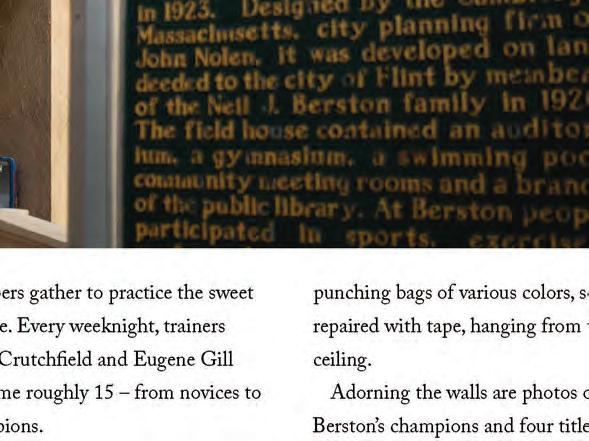


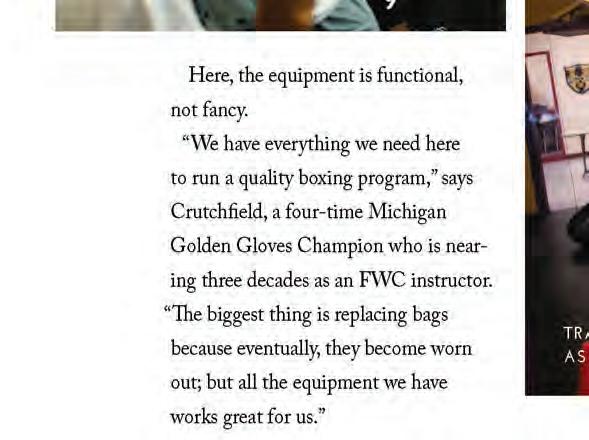



























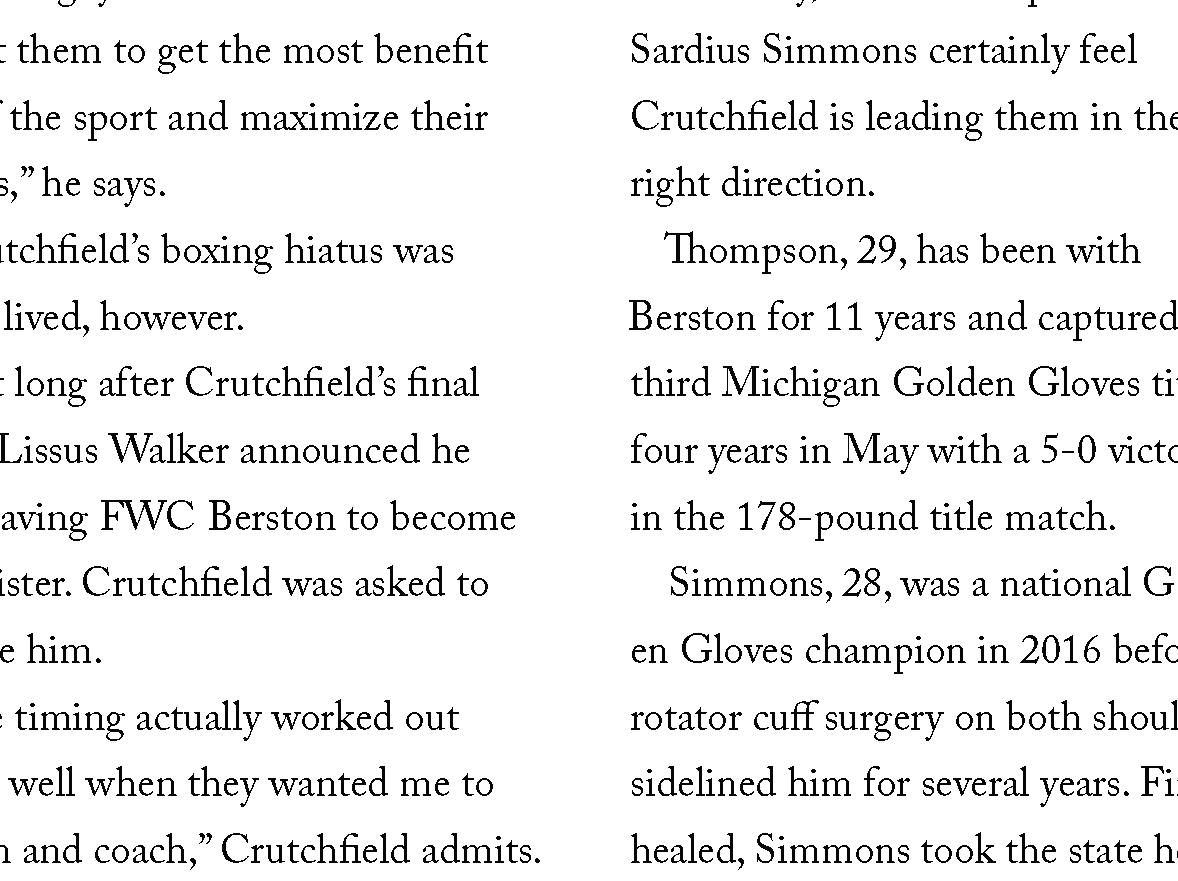



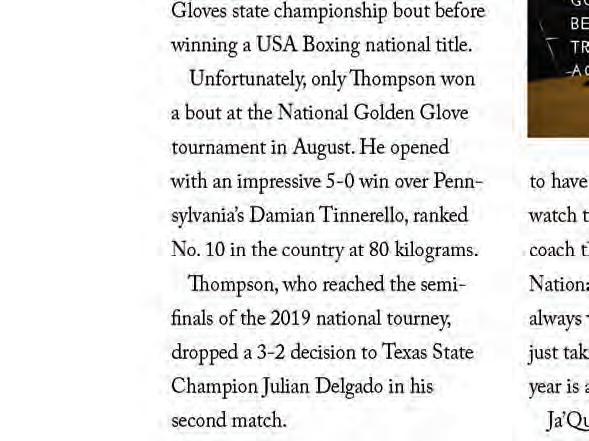




BY PETER HINTERMAN

Dr. Marty Kaufman, Professor of Geography, Planning and Environment at UM-Flint, and student Paul Mattern were worried. The planet was heating up, temperatures were pushing above normal and people were getting sick. “People don’t
“PEOPLE DON’T REALIZE IT, BUT EXTREME HEAT KILLS ABOUT 1,300 PEOPLE IN THE UNITED STATES EACH YEAR.”
Dr. Marty Kaufman

realize it, but excessive heat kills nearly 1,300 people per year in the United States,” explains Kaufman. “In fact, most heat-related deaths are attributed to other diseases and sickness that can be caused by excessive heat.”
Those who are the most vulnerable to heat are children and the elderly with personal isolation and certain environmental factors (lack of tree cover, asphalt, standing water, etc.)
contributing to the problem. With the goal of saving lives, Kaufman and Mattern searched for a way to create an excessive heat-warning system at the ground level. “We wanted to build a ground network to provide real-time heat readings,” the professor explains, “without relying on a satellite system that may not be telling the whole story.”
Mattern, who works as manager of planning and scheduling at MTA, had an idea. “He came up with a plan to
Mattern came up with a plan to install heat sensors at MTA bus stops around Flint. “They worked perfectly. The bus signs were the right height and their placement made sense.”
install heat sensors at MTA bus stops around Flint,” says Kaufman. “They worked perfectly. The bus signs were the right height and their locations made sense.”
The two turned to electrical engineer Dan Kurin to design and help build the sensors. “Each sensor is solar-powered and each circuit board had to be assembled by hand as funding was kept to a minimum,” adds Kaufman. “We had a shoe-string budget.” Last but not least, the project fell to Troy Rosencrants at UM-Flint’s Office of Economic Development. He developed the online dashboard of sensor locations, as well as mapping support. Forty operational sensors were distributed throughout the city and remain active.
The sensors record both the heat and humidity of an area to create a heat index otherwise known as apparent temperature. The value is recorded and sent via cell signal every half hour to an operating website. The website is

accessible to the public and shows the temperature of different sensor locations in the city in real time. Kaufman and his team have also devised a colorful warning system with green meaning “no caution” up to red – a location exceeding 120-degrees Fahrenheit. “We have already hit a few areas in Flint with temperatures exceeding 130 this summer,” says Kaufman. “We had a few days with 90-degree temperatures and 90% humidity. The combination of the two is what is most dangerous.”
In October, the team will pull and analyze the data. “The plan is to define
the heat islands (hottest areas) in the city as well as the current heating trend,” says Kaufman. Characteristics of the area will be noted to see what contributes to or lowers the heat. The data should prove important for city planners and public entities. If an area is found to be a heat island, planners and government officials can step in with ways to mitigate the heat such as building proper drainage, adding adequate vegetation and tree cover, or adding cooling stations where the vulnerable can escape the heat. “A big problem that no one realizes is lack of a cool-down period,” says Kaufman. “If there is a hot day followed by a hot
If you want to check the city’s temperature on the ground in real time and take a look at what Kaufman’s team is up to,
visit: https://bit.ly/3eKlroP.
night without a cool-down, it adds up.” Kaufman and his team are also looking into partnering with local hospitals to study the trend of sickness coming from the city’s hotter areas. “We expect there to be a correlation between heat islands and illness,” states Kaufman.
After the data is analyzed and recorded, the next step for the team is to publish their findings and then expand the study. “Hopefully, after we publish, we can receive funding to scale it upward,” says Kaufman. “We would like to distribute sensors in places like Detroit or Atlanta to see what is happening in larger cities and different areas. We would also like to move from a cellular signal to a WiFi signal which is much more reliable.”
As the world continues to heat up, studies like the one Kaufman and his team are conducting will become very important. Identifying the problem areas can help to mitigate future effects of heat on the population. Flint, through studies like this, is attempting to get ahead of the curve. “Flint is the guinea pig and we have gotten great cooperation from the people in the city,” says Kaufman.



























BY PETER HINTERMAN
From the early 1960s to the late 80s, the City of Flint rode a roller coaster of social and economic change. While the city made gains in social equality and culture, it lost ground in labor force and development. Crime began to rear its head as unemployment increased and business walked away. Population began to ˜ ee, leading to the ÿ rst (of many) school closings. ˛ e explosion of growth reversed and many mayors found that a lack of taxpayer funds inhibited future investment. After 1975, it was everything a mayor could do to keep the city a˜ oat.
˛ is series has tracked each of Flint’s Mayors throughout history, providing a short account of their professions, lives and decisions while in o˝ ce (if known). Some mayors were men/women of great deeds or of great controversy; some simply acted as placeholders in time. Each of them, however, chaired a city important to its country and its citizens on its path through triumph and heartbreak, and toward its revitalization.
For Part 1 in this series, see the 2022 January issue of My City
Born in Flint in 1926, Poulos was a resident of and dedicated to the city for his entire life. He was involved directly with city politics from 1960-74 as a city commissioner and councilman as well as mayor. He worked as an advertising sales representative for Ameritech Yellow pages for 25 years (retiring in 1987) and for a rewarding span of 30 years, he volunteered at the Bay Cliff Health Camp to work with children and adults with physical disabilities. As mayor, Poulos led the effort for the Eternal Flame at McFarlan Veterans Park. Also during his tenure, Mott Children’s Health Center and Northwestern High School were opened, and the legendary Dresden Hotel was destroyed due to fire. In the early ‘60s, civil rights issues and protests for fair housing were growing in every Michigan city, prompting Poulos to state at a mayoral meeting in Mackinaw City that the problem would have to be dealt with and that he was disappointed with the way most cities were handling it. Indeed, the issue would soon come to Flint. Poulos was a member of the National Museum of the U.S. Air Force, the American Museum in Britain, the American Legion, and the 8th Air Force Historical Society. He passed away in 2014.
Born in 1911, Cull was one of Flint’s biggest supporters and a firm believer in education first and foremost. While in office, he successfully rallied the Michigan State Board of Education for an expansion of the University of Michigan-Flint to include a freshman and sophomore class stating, “We consider this part of the total pattern of community growth … The project has the enthusiastic support of the entire community, particularly those young people who would be unable to afford a university education if they had to live away from home.” Cull also acted as city clerk for several years. During his tenure, the City Commission began efforts to relocate 3,000 families due to the impending construction of the I-69 and I-475 expressways. Outside of politics, Cull owned and operated the Harry K. Cull Insurance Agency in Flint and was a member of the Masonic Lodge. Cull passed away in 2000 at the age of 89.
Flint could not have picked a better time for Floyd J. McCree to come to office. Housing was an issue for the decade preceding his tenure and the problem was soon brought to the forefront in Flint due to the national Civil Rights movement and the installation of the I-69 and I-475 expressways. Routed through predominantly black neighborhoods, the expressways displaced black families which, due to the practice of redlining in the city, had nearly nowhere to go. McCree spent his tenure advocating for open housing and equal employment opportunities in the city. Flint’s first African-American mayor, McCree was born in St. Louis, MO in 1923. He served in the South Pacific during World War II and rose to the rank of staff sergeant. He then came to Flint and took a job at the Buick Foundry where he became foreman and then, supervisor of maintenance. At Buick, he organized the Foundry Council with Edgar Holt to obtain equal pay and rights for Black workers. He was elected to the City Commission in 1958 and as mayor, was instrumental, along with other local activists, in the passage of the first major open housing city ordinance in the United States, threatening to resign his position if equal opportunity wasn’t given. In 1967, he stepped in to quell violence during the Detroit and Flint riots. Following his mayorship, McCree continued to serve on the City Commission until 1970. In 1971, he became the Genesee County Register of Deeds. In 1975 and 1979, he ran for Flint Mayor against James W. Rutherford, losing both times. On April 4, 2022, a bronze statue of Mayor McCree was unveiled in front of Flint City Hall.
Born in Flint in 1929, Cronin has lived in the city all his life. He graduated from Flint Central High School in 1947, attended Mott Community College and then Central Michigan University. He acted as City Councilman from 1966-68. He was an avid soap box derby fan and as mayor, pushed for construction of a permanent racetrack in the city. He got his wish when Cronin Derby Downs opened in 1969 near the grounds of Flint Southwestern High School. The city would go on to produce multiple derby champions until the racetrack’s closure. In the beginning of 1969, after the landmark vote for open housing in Flint, Cronin presented the key to the city to Edwin C. Berry, Executive Director of the Urban League of Chicago, during his visit. Cronin stated during the presentation, “I’ve been asked what this key opens. It doesn’t have to open anything because everything in Flint is open to everyone.” He then boasted that “Flint is the most progressive city in the country.” In his acceptance speech, Berry mocked this claim causing some controversy. More controversy occurred in 1970, when Cronin along with commissioners Fred Tucker and George Sahadi Joseph, was indicted for bribery. Charges against Cronin were dropped when insufficient evidence was found to convict him of a crime. Also during his time as mayor, the Genesee Towers, the IMA Sports Arena, and Williams Elementary opened and the Urban Coalition was formed. After leaving the office, Cronin became heavily involved in the fight against drunk driving through his support of M.A.D.D. and Nu-Path. He was named the Genesee Bar Association Person of the Year in 1994 and the Michigan Bar Association Person of the Year in 1997. Cronin served as a longtime usher at St. Matthew’s Catholic Church and was a member of the Elks. He died in 2006.
Until his appointment as mayor in 1970, Limmer worked as city clerk. He had a reputation as a bit of a wheeler-dealer, and using his skills he brokered a deal to acquire City land (including Wilson Park) and transfer all land and structures to the University of Michigan to expand the local campus. His very nature increased office oversight as evidenced when the Flint Journal challenged his policy of holding secret council meetings in addition to regular sessions. This led to the ruling that no meeting in which public business is considered and which ultimately leads to a vote or involves issues of public concern can be closed to the public – a rule still enforced today. As mayor, Limmer oversaw construction and opening of the New Northern High School and the opening of Dort Music Center (the first home of the FIM). Also during his tenure, Powers Catholic High opened its doors. In 1971, Limmer founded the Limmer Investment Corporation, the first of many side businesses that included the Michigan & Indiana Communications Corporation in 1978, G T & T Communications in 1981, and G T & T Limited Partnership in 1986. He and his partners found themselves in hot water with the S.E.C. from 1987-90 when it was shown that investors were misled through omissions of information to the tune of $3 million in unregistered promissory notes. Limmer and associates got off with nothing more than a warning.

e last mayor selected by the city commission, Visser graduated from Kearsley High School in 1954. He worked as a journeyman electrician until 1966, then served as assistant to congressman Donald Riegle until 1971. He became an agent for Mutual Life Insurance Company and was named “Flint Agent of the Year” 13 times. He went back to school and graduated from American College in Pennsylvania with a Master of Science in Financial Services. From 1972-73, Visser served on the Flint Civil Service Commission before being named mayor. During his tenure, Visser was perhaps the rst mayor who began to make cutbacks due to lost tax revenue, economic instability and a downturn in city population. He was the rst to oversee a school closure (Doyle Elementary) due to low enrollment – a trend that continues today. After his tenure, Visser continued public service on projects with the United Way, Goodwill and e Salvation Army. He acted as president of the Flint Rotary Club and was the founding chairman of the Flint Cultural Center Corporation. In 1998, Visser was named C. S. Mott Citizen of the Year. He was inducted into the Kearsley High School Hall of Fame in 2022 for his many civic and professional
In 1974, the City Charter was rewritten and mayoral elections were once again determined by public vote. (˜ e last elected mayor was Ray A. Brownell in 1930.) ˜ e ÿ rst election of the modern age pitted former police chief James W. Rutherford against former Mayor, Floyd J. McCree. Settled by a mere 205 votes, Rutherford came out on top by running a campaign focused on reduced crime and public safety. Born in Flint in 1925, Rutherford attended Flint Central High School and then served in the U. S. Navy. On his return to Flint, he joined the police department and by 1953 was promoted to detective. Rutherford attended Flint Junior College, graduating in 1958, and then Michigan State University where he obtained a degree in police administration in 1960. ˜ e next year, he assisted Flint Junior College on the implementation of their own police administration program. He was promoted to police chief in 1967 and resigned in 1975 to run for mayor. In 1977, Rutherford appointed a special task force to study mortgage redlining and found that the practice still continued in Flint unabated, leading to population decline and blight. Taxed with smaller revenue, Rutherford donated $22,000 for the purchase of a city ambulance. In 1978, to help ÿ ll the co˛ ers, Rutherford supported an attempt to annex land from Flint, Mt. Morris and Mundy Townships (including the Genesee Valley Shopping Center). ˜ e attempt failed.
After beating Floyd J. McCree in a second mayoral race in 1979, Rutherford laid o˛ 300 employees and slowed garbage pickup in an attempt to balance the budget (and alleviate a $17 million deÿ cit). Hoping to “save” the city, with the backing of the Mott Foundation, he announced the purchase of the I.M.A. Auditorium and its annex for the development of AutoWorld – a project that was due to cost a minimum of $38 million. In addition, the amusement park brought with it the Hyatt Regency Hotel, Water Street Pavilion and Windmill Place. Rutherford lost his bid for a third mayoral term to James Sharp by over 1,000 votes. After his tenure, Rutherford started the Rutherford Group, Inc., worked as head of public relations for Windmill Place, and as director of the Flint Downtown Development Authority in 2003. He won another brief stint as mayor in 2002 after the recall of Woodrow Stanley. Rutherford died in 2010; the Downtown parking structure at 125 W. Kearsley St. is named in his
e city’s rst popularly elected Black mayor, Sharp was born during the Great Depression and grew up in Harlem and then e Bronx, New York. After graduating high school, he served as a Marine in the Korean War and three years in Vietnam, earning three Medals of Valor and the Vietnam Cross of Gallantry. Upon his return to the States, Sharp worked for 11 years as chief aide for Senator Don Riegle, Jr. where he learned the art of politics and governance. As Flint’s Mayor, he worked hard to lower crime rates by leaning on family values and working with city gang members. His controversial “opinion leaders” program hired 28 gang members to clean around city hall and the police department, gaining respect for gang members and getting them o the streets. He then advocated for the Board of Education to require 75 hours of community service for graduation to help students learn respect for city organizations and its population. In 1984, he opened AutoWorld and sadly, was on hand in 1986 to close it for good. In 1985, he fended o a recall attempt. In 1987, he lost the mayoral election to Matthew Collier by more than 2,000 votes. e next year, Sharp was appointed to the Oakland University Board of Trustees and acted as board chairman for Oakland University from 1992-94. In 1995, he and his wife Tessie established the James A. Sharp, Jr. and Tessie Baltrip Sharp Endowed Emergency Loan Fund for college students to use in nancial emergencies to avoid interruption of their chosen career education. In 2017, Sharp received an honorary Doctor of Humanities degree from Oakland University. After retiring to Arizona, Sharp continued to advocate for the City of Flint during the recent water crisis.











9/9-11.2022
PHOTOS BY KATY KILDEE
This huge event kicked off with hundreds of bikes revving up and taking off from Vehicle City HarleyDavidson for the annual Ed Henderson Police Escorted Ride for charity. The ride ended in Downtown Flint where thousands gathered to display their bikes of every kind and swap “road warrior” stories. The event included the popular Police Skills Competition on the Flat Lot, a Rockabilly Pinup contest, a daredevil motorcycle performance by Urias Globe of Death, and a beer tent with live entertainment by John Vance Band.
Find more photos of this event at mycitmag.com






A Michigan tradition since 1957, this familyfriendly fiesta had it all! Live entertainment included a beautiful dance performance by El Ballet Folklórico Estudiantil and live music by Conjunto Rey de Pontiac, Grupo Viento, and Karizma Band de Holland. Enjoying the late summer sunshine, attendees gathered for fellowship and delicious, authentic food and desserts, as well as many craft and product vendors, a beer tent, Mexican Bingo and a taco eating contest.
Find more photos of this event at mycitymag.com







8th Annual Night at the NEW Museum Grand Gala
9.17.2022
Photos by Katy Kildee
Attendees of this red-carpetthemed, formal event in the fantastic and newly opened museum enjoyed delicious food and beverages, live music and dancing. Silent and live auctions raised important funds for Sloan’s educational and STEM programming.


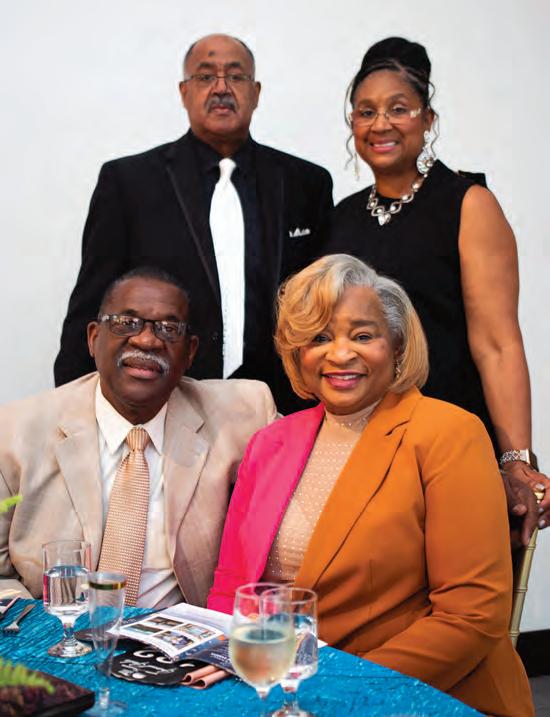




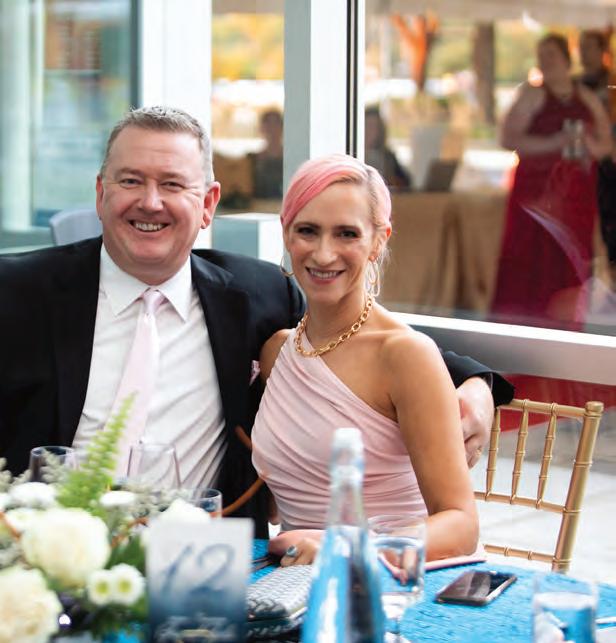















Warwick Hills Golf & Country Club 9.19.2022
PHOTOS BY MICHAEL GLEASON PHOTOGRAPHY


On a gorgeous, nearly fall day, 44 teams enjoyed a round of golf, multiple games and activities. Once again, the Greater Flint business community provided generous support of the annual event, with additional funds raised through a silent auction that was open to the public for bidding. Founded in 1926, Whaley Children’s Center is an independent, 501 (c)(3) nonprofi t organization that provides residential care services to children ages 5-17 years old who have suffered chronic and profound abuse and neglect.










Most people have seen “Independence Day,” a 1996 lm about an alien invasion. If you haven’t, here’s a spoiler alert:

BY VERA HOGAN

In one scene, the President of the United States tries to communicate with an alien being that crash-landed in the desert and was captured by the Army. He asks the being, “Can there be peace between us?” e alien responds, “No peace,” at which time the President suddenly grabs the sides of his own head, his eyes rolling back before he collapses. When he recovers, he reports to the others that the alien had revealed to him the intentions of his species. “ ey’re moving from planet to planet,” he says, “consuming every natural resource before they move on – and we’re next.”
Sounds far-fetched, right? Not really. Isn’t that what we’re doing to our planet? Except that unlike the movie, we have nowhere else to go.
Over the past 100 years, our desire for modern conveniences and resulting carelessness about getting them could have catastrophic results for our species. It has already begun.
I’ll be the rst to admit that I have been doing the bare minimum when it comes to practices that will help, or at least not harm, the environment. I recycle glass, plastic and paper products weekly through my community’s waste and recycling programs. But is that enough? I don’t think so. When it comes to saving the planet, we all need to do more.
What I once thought was not going to happen in my lifetime is happening, and it is terrifying.
When I see on the news, for example, that Lake Mead is drying up, it gives me pause to worry about our


country’s water supplies. When full, Lake Mead holds 9.3 million gallons of water. It pumps water from the Colorado River to supply Arizona, Nevada, California and parts of Mexico. Because of climate change, this water source could completely dry up in 13 years. Scientists say Lake Mead is half empty now and probably will never ll up again.

Consider this: each year, the clothing industry uses over 20 trillion gallons of water to produce garments. It takes just over 2,000 gallons of water to manufacture ONE pair of blue jeans. In 2019, nearly 400 million pairs of jeans were sold in the U.S. Do the math. e money spent on water to make jeans could re ll Lake Mead multiple times! I’m not suggesting we all run around half-naked, but do I need ten pairs of jeans? No, I don’t – not many people do. is is just one of hundreds of examples of how our natural resources are being depleted.
I’m not going to list all the things individuals can do to aid in the survival of our planet. ere are countless legitimate websites that provide that kind of detailed information. Rather, I’m going to continue doing my part to help and I hope you do, as well. Waiting until tomorrow is no longer an option because as I said: we have nowhere else to go.

Recently retired, Vera Hogan is a 20year veteran of the newspaper business, having served both Fenton and Flint area publications. During those years, she was a reporter, associate editor, editor, web content editor and columnist. Her popular columns have earned her multiple state awards. She resides in the City of Fenton. Email verahogan@hotmail.com.























BY DR. CHRISTOPHER DOUGLAS
Electric vehicles (EVs) are touted as a remedy to high gasoline prices – unfortunately, the math doesn’t support this. An EV costs, on average, $10,000 or more than a gasoline powered car. A 2022 Hyundai Ironiq 5 electric SUV costs approximately $15,000 more than 2022 Hyundai Tucson, a similar-sized vehicle. An at-home charger adds another $700.
EV e˛ ciency is measured in kilowatts-hours (kWh) per 100 miles, which is the kilowatt-hours required for the EV to drive 100 miles. EV e˛ ciency varies across vehicles, with average EV e˛ ciency being 35 kWh per 100 miles. ˜ e most e˛ cient EV is the 2021 Tesla Model 3, requiring 23.7 kWh to drive 100 miles. ˜ e least e˛ cient EV is the 2022 Audi e-tron S, requiring 53.3 kWh per 100 miles.
Residential electricity in Michigan costs 17.65/kWh. ˜ us, it would cost $4.18 to charge the most e˛ cient EV to drive 100 miles, $6.17 for the average EV, and $9.40 for the least e˛ cient EV. A private charging station will likely charge more than this.
˜ e average gasoline powered vehicle gets about 25 miles per gallon (mpg) with some vehicles, such as the Toyota Corolla and the Honda Civic, getting 35 mpg. Assuming gasoline costs $4/ gallon, it would cost the average gasoline car $16 to drive 100 miles with the Corolla and Civic costing under $12 to do so.
Assuming a driver drives 15,000 miles a year, a driver of an average gasoline powered vehicle would spend $2,400 on gasoline while the driver of a Corolla or Civic would spend $1,714. A driver of an average EV would spend $627 on electricity, assuming all charging is done at home. A driver of the most e˛ cient EV would spend $627 on electricity while the driver of the least e˛ cient EV would spend $1,410.















˜ us, an average EV saves $1,475 in gasoline compared to a gasoline powered vehicle that gets 25 mpg. ˜ is means it would take about seven years to pay back the additional $10,000 price of the EV, making the EV a break-even proposition as a new vehicle has an average life expectancy of about eight years. It is worse than break-even to purchase an EV if the driver must replace the battery; replacing a battery out-of-warranty can cost upwards of $20,000 – nearly the cost of a new vehicle.
Some people wondered if they should trade in their gasoline-powered vehicle for an EV when the price of gasoline increased by $2/gallon in the ÿ rst half of 2022, hitting a peak of $5.15/gallon on Memorial Day weekend. ˜ e average tradein value of a used car is about $17,000. Purchasing a $40,000 EV would thus mean spending $23,000 to save this $2/gallon increase, a payback period of over 19 years, which is longer than the life of the car.
Unless there is a breakthrough in battery life, lower EV prices, or gasoline prices substantially increase above $5/gallon, purchasing an EV to avoid high gas prices does not make ÿnancial sense. Consumers are stuck with higher gasoline prices for the foreseeable future.

Dr. Christopher Douglas came to the University of Michigan-Flint in 2006. He earned a B.S. in Electrical Engineering and a B.S. in Economics from Michigan Technological University in 2001, and his Ph.D. in Economics from Michigan State University in 2007. As Associate Professor and Chair of the Department of Economics, he teaches Principles of Microeconomics, Principles of Macroeconomics, International Economics, Public Finance, and Sports Economics.







BY LESLIE TOLDO
Before you answer the title question with a pithy, “I am not a candy,” read on.
Based on my internet research, it turns out that we are all defined by Halloween candy. I am not necessarily talking about your candy choice, either. The candy may choose you
I took the “Which Halloween Candy Are You” quiz on buzzfeed. com — I did it because I always find personality quizzes amusing. All I had to do was answer a bunch of questions about things such as my taste in scary movies, and dog costume preferences.

I really do like Tootsie Rolls. That, according to one quiz, means I’m having trouble paying off my student loan. Ha! I don’t even have a student loan.
The results? I am, apparently, candy corn.
My entire sense of self worth is now shot. I do not like candy corn. In essence, this may mean that I don’t like myself. In fact, a separate quiz I found actually says that if candy corn is your favorite, you do not like yourself. That’s harsh; but if I was candy corn (and I am so NOT) no matter what the first quiz said, I would hate myself.
I am trying to remember that these are just silly quizzes, but I am developing a complex.
Another quiz that defines you based on your candy of choice, declared anyone who prefers candy corn to be a psychopath. I can actually get on board with that.
According to that same quiz, anyone who opted against candy and chose dental floss or fruit for their favorite treat, was a party pooper. I can get on board with that, also. Another quiz bluntly breaks the news that you are a “loser” if you really get excited to find a box of raisins among the treats collected in your plastic pumpkin.
“Wait a second,” you say, “raisins aren’t candy!”
I must remind you, my friend, that raisins are, in fact, “nature’s candy.”
Not my decision — some advertising executive got paid a lot of money to come up with that one.

The Candystore.com 2021 rankings listed candy corn as the worst candy. That doesn’t help my confidence much. Reese’s Peanut Butter Cups ranked the best candy and topped the candystore. com “Favorite Halloween Candy” list. The site also breaks down the rankings by state, and candy corn ranked second in Michigan last year. What was number one in The Mitten? Who cares? (Starburst). Candy corn came in tenth overall. Of all the candy out there, at least it made the “10 Best” list.
I have managed to come up with around 500 words chosen to make myself feel better about being called “candy corn” by an online quiz. Maybe I need to look in the mirror and ask myself what I see. Is it just a triangle-shaped, white, yellow and orange hunk of sugar?
I guess this year, instead of getting treats, I got tricked. Whatever you do, do not open the big, scary Halloween Candy Quiz … the answer just might terrify you.
An Emmy-nominated anchor/meteorologist/reporter at FOX66 and NBC25, Leslie Toldo has worked in TV news for over 30 years, nearly 20 in Flint. She is a blogger, writer, wedding and funeral officiant. Born and raised in Baton Rouge, LA, she graduated from the University of Wyoming. An avid kayaker, boater and runner, Leslie lives in Linden with her husband, Ellie the cat and three dogs: Bear, Gus and Lucy.




























BY JOEL LAGORE, CFP®, AIF®


For the past few decades, few things have been as dependable as the annual increase in tuition fees for post-secondary education; but for the ÿ rst time in a very long period, the growth rate for tuition has decreased. According to College Board, we are seeing a drop-o° in average tuition for the ÿ rst time in 30 years.
Since this is the ÿ rst time this has happened in a very long time, we cannot make any deÿ nitive assumptions because it could be a one-o° ; but it does seem to raise some red ˛ ags about what the future holds for college costs. According to the National Student Clearinghouse Research Center, admissions at post-secondary schools have been declining since the pandemic and we can assume that the price of tuition decreasing would be a reaction to these ÿ gures. ˝ e question now is whether this is just a change because of COVID or is there a bigger shift happening? Given the current headlines, student debt is something many feel needs to be focused on by the federal government and is more than likely making many reconsider whether a traditional, four-year degree is actually worth the cost.
˝ e current job market is also, more than likely, a° ecting college admissions – there are still two jobs out there for every person seeking employment. With so many opportunities, it seems plausible that many are going straight from high school into the job market since it is so much less competitive than in years previous.
In Michigan, we have a few di° erent options when it comes to saving for education: a Michigan Education Saving Plan 529 plan, a Michigan Educational Trust account (MET), and a Michigan Uniform Transfer to Minor Account (MUTMA). Each type has their own beneÿ ts and drawbacks, but we need to see what e° ect a

potential drop in tuition prices would have on each one.
˝ e MET plan lets you purchase college hours at today’s prices, which typically would be very advantageous given the past history of tuition increases, but isn’t nearly as advantageous if college tuition drops signiÿ cantly in the future. When we look at a 529 plan, the assets must be used for post-secondary education, or the growth will be subject to a 10% penalty and potentially taxed.
˝ ere are rules that allow for transferring to siblings or direct family members if a child does not use all their funds, but it is a great idea to check your plan to make sure that you are not out-saving the changing costs of tuition.
A MUTMA o° ers the greatest ˛ exibility since the funds can be used for anything, not just education – perhaps the child receives a scholarship or chooses not to pursue college. ˝ e account is held in the child’s name with the adult as custodian of the assets until the child reaches age 18. ˝ e MUTMA is also the most restrictive when it comes to taxation due to the kiddie tax rules.
It can be assumed that in terms of college tuition, something is shifting when it comes to the coming generations’ perceptions about education and how important it really is. We could see some decrease in tuition costs until we get to a point where the market feels it is at a fair price. ˝ is does not mean we need to abandon one type of educational savings vehicle or stop saving for education altogether; but going forward, we need to make sure that we adjust our savings and ensure that we are using the correct savings vehicle if this does indeed happen. ˝ is is a normal part of investing – once a plan is in place, it must be revisited and reassessed to ensure that our plans still align with our goals.
Joel P. LaGore, Certified Financial Planner and partner with OLV Investment Group, focuses on money management. Joining the Downtown Flint revitalization effort, his office is located in The Durant at 607 E. Second Ave., Suite 100. Joel and his wife Sonya are raising two daughters in Flushing, where he enjoys philanthropic pursuits in his local community, in Flint at large and in Genesee County.

“I am truly proud of what we have done w Ith the learnIng Commons and I do belIeve that It Is exCeptIonal.”
Dr. Robert K. McMahan, President
In addition to d.spaces, the Commons is host to Kettering’s library services. Dubbed “Knowledge Bars’’ the library operates digitally, providing students access to the most up-to-date journals. At the ground level, the Battenburg Café offers food services including brick-oven pizza. (The café has no tables or chairs; students have full mobility to eat wherever they wish.) On the second floor, the Great Lakes Coffee Company provides caffeinated energy. “When we first experimented with d.spaces,” adds McMahan, “students told us that they would stay there all day if they could get food. We listened to them, and food services are an important part of the Learning Commons.” The facility also features an outside terrace and auditorium, IT services, a maker’s space with all tools and components for fabrication and design, a kiva and an art gallery. There are only three spaces in the building without direct, line-of-sight transparency – the inside auditorium, reflection room and visiting guest suite. “The reflection room is a place where students can relax, do yoga and clear their minds,” explains Kettering Senior Communications Coordinator, Crystal Garcia-Tyler. “The guest suite is for visiting professionals or instructors and acts as a hotel room.” The guest suite is connected to the auditorium for ease of travel. The building is open 24/7 for students and they have freedom to work and collaborate in any area they wish.
After two years in construction and $63 million spent (by way of donations and gifts), the Kettering Learning Commons is a space to behold. “You know, most university presidents feel that they have to be a cheerleader for their institution, no matter what. I’ve never felt comfortable with that,” says McMahan. “However, I am truly proud of what we have done with the Learning Commons and I do believe that it is exceptional.”


BY CHERYL DENNISON
Didyou know that breast cancer is among the most commonly diagnosed cancers and the second leading cause of cancer death among women in the United States? According to michigan.gov, approximately 287,850 women will be diagnosed with breast cancer and nearly 43,250 will succumb to this malignancy in 2022.
In September, I had a health scare that truly made me aware of this insidious disease that a ects so many women. I had my annual physical exam at McLaren Fenton, which involved a series of tests: bone scan, lung scan, blood work and a mammogram. I had my mammogram at the McLaren FentonImaging Center, which uses the latest 3D technology. When I received the results, I was told that an abnormality was discovered and that I would require additional testing at the McLaren Imaging Center in Flint.
Another mammogram was performed there and after reviewing the results, the radiologist concluded that a biopsy of my right breast was required and that there was an appointment open for the test on the following day. I have always been a healthy person and previous mammograms have shown that I have dense breast tissue. So, I wasn’t too concerned, but a little bit worried about what the test would nd.
My appointment was at 9:30am and on the way, I was stopped at the train tracks on Van Slyke Road heading to Ballenger Highway, as there was an accident at the Bristol Road expressway exit that I wanted to avoid. I sat there for 20 minutes and the train wasn’t moving – many drivers were turning around. I knew I was going to be quite late, so I called McLaren and they told me to just get there as soon as I could (darn it!)
I don’t like needles! e biopsy required two injections for numbing and then, the actual needle to take the tissue sample. I was a little scared; but the nurse and doctor put me at ease and the entire process was not as painful as I thought it would be. It took ve business days to receive the biopsy results. e McLaren nurse, Val, who was as compassionate as any nurse I have encountered, called me on the fth day. “Get ready to celebrate!” she announced – the biopsy results were negative (a big sigh of relief from me). I feel very lucky, as I have some friends who were not so lucky and went through treatment (with very good results, thankfully). I now have a new sense of empathy for them.
October is Breast Cancer Awareness Month and there are many activities in Greater Flint that help raise awareness and funds. e 14th Annual Pink Night Palooza takes place on October 20. is year, sponsors and attendees will be able to choose where their donations go – Hurley’s Breast Cancer Navigation Fund or General Cancer Services Fund to bene t research and treatment of ALL types of cancer (see p.36).
e Flint Making Strides Against Breast Cancer walk will take place on Saturday, October 22. Making Strides is an event that unites communities, companies and individuals with a collective goal to end breast cancer as we know it. e movement raises lifesaving funds that support breast cancer patients, survivors and caregivers through every step of their journey.
Check-in for the Flint Making Strides walk is at 8am and the walk begins at 9am at the Downtown DDA Flat Lot. Please come out and support this worthy cause! Your support helps fund the future of breast cancer research and programs for our loved ones today, and for the next generation. I hope to see you there!
Recently, Tonya completed a project that will help keep her family’s history alive: a Japanese Garden located at Mundy Miracle Commons. ˜ e 99-acre park of woodlands, wetlands and paved walking trails is located o° Hill Road in Mundy Township. Tonya funded the garden, which was designed to be a quiet place of re˛ ection – a labor of love and a living tribute to her family. “˜ is is my gift to the Township,” she says. “I was a Girl Scout and was taught to always leave land as good or better than how I found it.”
A ribbon-cutting for the opening of the Japanese Garden was held in August in honor of the family. Family members from all over the country and the state traveled to attend the event. ˜ e garden features a large sign depicting a timeline that highlights the Curtis/Ketzler family’s 170 years of horticulture in Mundy Township.
In 2018, Ketzler Florist was purchased by Waneita Bovan, Tonya’s previous employee at the ˛ ower shops in Swartz Creek and on Hill Road. Coming from three generations of ˛ ower shop owners herself, Bovan is proud to continue the longevity of family businesses. “˜ at is extremely important to me,” she shares. She wants to not only uphold the standards established by the Ketzler family, she also wants to contribute to the community. “Tonya taught me about that. I also learned a lot of strong business practices from her.” Bovan hopes to continue community involvement, especially through horticulture at Mundy Miracle Commons and making sure the Ketzler family name lives on.

Tonya Ketzler is very proud of her family’s history and will continue to honor it. “I come from good roots!” she exclaims.







BY ALEXANDRIA NOLAN


Haveyou ever visited a place that took you by surprise?
A place that was better than you imagined, somehow more in every way?
This summer, I went on a day-trip to Tossa de Mar. My best friend, Patricia, lives in Barcelona and she and her husband make the hour-or-so-long trek to Tossa in the summer months when they are both on holidays. These small beach towns are a favorite with native Spaniards to escape the tourist crush on the beaches closer to Barcelona. She had been talking about the beauty of the beach, the quaintness of the village, the slow, relaxed atmosphere of the whole place. She’d also mentioned the local seafood and wine a time or two, and all of these details had stacked in my mind to create some pretty lofty expectations.
And ... Tossa met and exceeded them all. Driving into the small town, the beach comes as a sort of surprise. One doesn’t really get a good look at the water until you’re almost on top of it. From the road in, Tossa de Mar just appears to be like any other small Spanish city in Catalonia. But when you do approach the water, it is blue as blue can be. Sapphire blue, cerulean, deep lapis blue water and so many people, laid out, worshiping the sun, the sea and holidays in general.
On people of the older generation there is barely a swimsuit top to be seen. Topless, unashamed and bronzing in the sun, all kinds of breasts are out. It is a liberating sight, to see so many women comfortable with themselves, real bodies and a nonchalance that confirms that their partial nakedness is the last thing on their minds. And so it is that the beach feels a little more like freedom, a little more like a real holiday, away from expectation and judgment and following “the rules.”
A few hours spent in the bright sunlight and in the salty sea works up quite an appetite. And a stroll along the beach into

the heart of Tossa will introduce you to the sweetest little set of shops and restaurants. Tiny, family-run places whose tables and chairs spill into the street as if the restaurant was simply too excited to contain them. Tiny sardines flash fried, croquetas and camarones that were swimming around in the same water and coated in the same salt we are. Sparkling wine, Cava sangria and Pedro Jimenez sherry from Jerez. We eat patatas bravas and escabeche and gildas, olive and anchovy skewers with peppers, salty and vinegary and just perfect with sparkling wine.
After our meal, which concluded with cafè con hielo, (just espresso over ice) we headed across the way to a little shop that sells straw hats as the bright sun and too much wine have convinced us we all need one. And then it’s back to the beach, to sun, to climb to the top of the torre and look down over all of Tossa, to find another place that serves cold drinks and views of the blue. I hear no English spoken anywhere, and if I pretend just right I can pretend that this is my native tongue, my normal holiday, my typical August Tuesday in Spain.
But the sun is relentless and we are salty and sandy and sticky and it’s time to climb back into the car and head to the city once more. A little more bronzed, a little more relaxed and a lot happier. Tossa de Mar is a little bit of magic, a little bit of a different world, just a short drive from the hustle and bustle of busy Barcelona.

Alexandria Nolan is a misplaced Michigander living in Houston, TX with her husband, three pets and toddler son. She is a published author and contributor to various online and print publications, including a lifestyle blog, AlexandriaNolan.com. When not writing, she is reading, traveling, or reading about traveling.


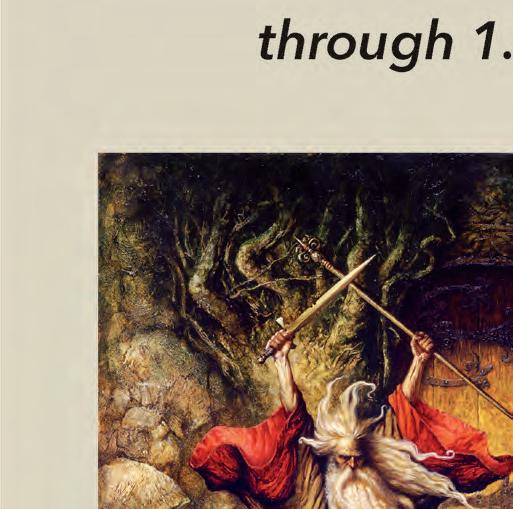









“Censored on Final Approach”
Clio Cast & Crew
10.7-16.2022
Davison Pumpkin Festival
Downtown Davison
10.8.2022
FIM’s Cars & Bars Fundraiser
Bobby Mukkamala’s Warehouse 10.12.2022

“Rocky Horror Picture Show” Featuring Barry Bostwick
The Capitol Theatre 10.13.2022
FSO Presents: Rachmaninoff & Tchaikovsky
The Whiting 10.15.2022
Ward Davis
The Machine Shop 10.15.2022
Dru Hill & Dave Hollister
The Capitol Theatre 10.15.2022
Flint Firebirds vs. Sarnia Sting
Dort Financial Center
10.19.2022

Pink Night Palooza
Davison Country Club 10.20.2022
Fernando Silverio Solis Y El Sueño
Flint City Hard Cider 10.22.2022
Flint Firebirds vs. Windsor Spitfires
Dort Financial Center 10.22.2022

“R.E.S.P.E.C.T.” The Aretha Franklin Tribute The Whiting 10.27.2022
Absolute Queen
The Machine Shop 10.27.2022
The Isley Brothers The Capitol Theatre 10.28.2022
“Rocky Horror Picture Show” Fenton Village Playhouse Theatre 10.28-29.2022
Flint Firebirds vs. Oshawa Generals

Dort Financial Center 10.29.2022 See you

















BY PETER HINTERMAN
For those who choose to observe it, it’s “spooky time” again. Each year in October, many of us do our darndest to scare the willies out of each other and ourselves. We watch scary movies, visit “haunted” houses, and search for the most frightening costumes with the goal of experiencing a little bit of that most universal of emotions: fear.
Most of us know why we experience fear; it’s our bodies’ way of getting us ready for a threat to our lives or livelihood. But, how does the whole system work?


e human fear response starts in the portion of the brain called the amygdala – its purpose is to detect the emotional importance of external stimuli. It activates whenever we see a human face with emotion or anything else that can be perceived as a threat. For instance, if we are walking down a path and see a wild dog, the amygdala immediately perceives the dog as a threat and activates our “ ght or ight” response leading to bodily changes such as enhanced brain activity, dilated pupils, accelerated breathing and heart rate, and increased blood ow to our muscles. After the amygdala activates, the brain’s hippocampus goes to work to interpret the perceived threat, determining whether it is real. To explain, the


sight of a wild dog on your path is perceived by the amygdala as a threat; however, the hippocampus and prefrontal cortex understand that the dog is on a leash handled by an owner. e threat response is deactivated as the dog is no longer scary.
is explains our universal fear of the dark and unknown. When we hear a “strange” sound outside such as a tapping on the window at night, the amygdala activates but the hippocampus cannot instantly determine that the sound is NOT a threat due to the dark. Only when we determine that the “tapping” on the window was a tree branch blowing in the wind, can the hippocampus cancel the fear response. e amygdala also acts much faster than the hippocampus, leading to instances when we are “surprised” by a friend, causing our heart to race before the hippocampus recognizes the actual situation.

Just know that the feeling of dread you experience listening to the mysterious scratching at your bedroom door or the face you see leering from the shadows in the middle of the night, could be nothing more than uncertainty run amok. Do you investigate … or hide beneath the covers?













